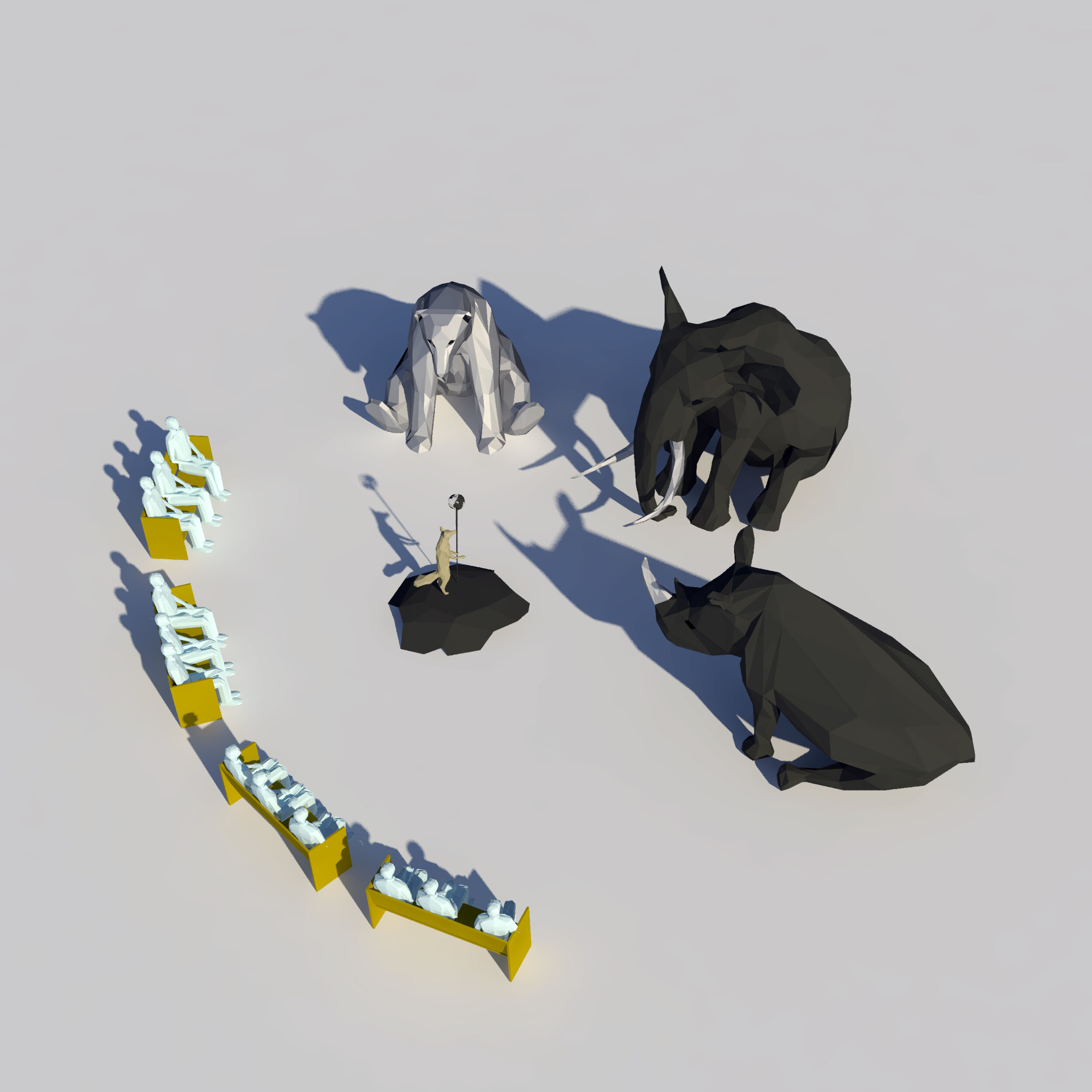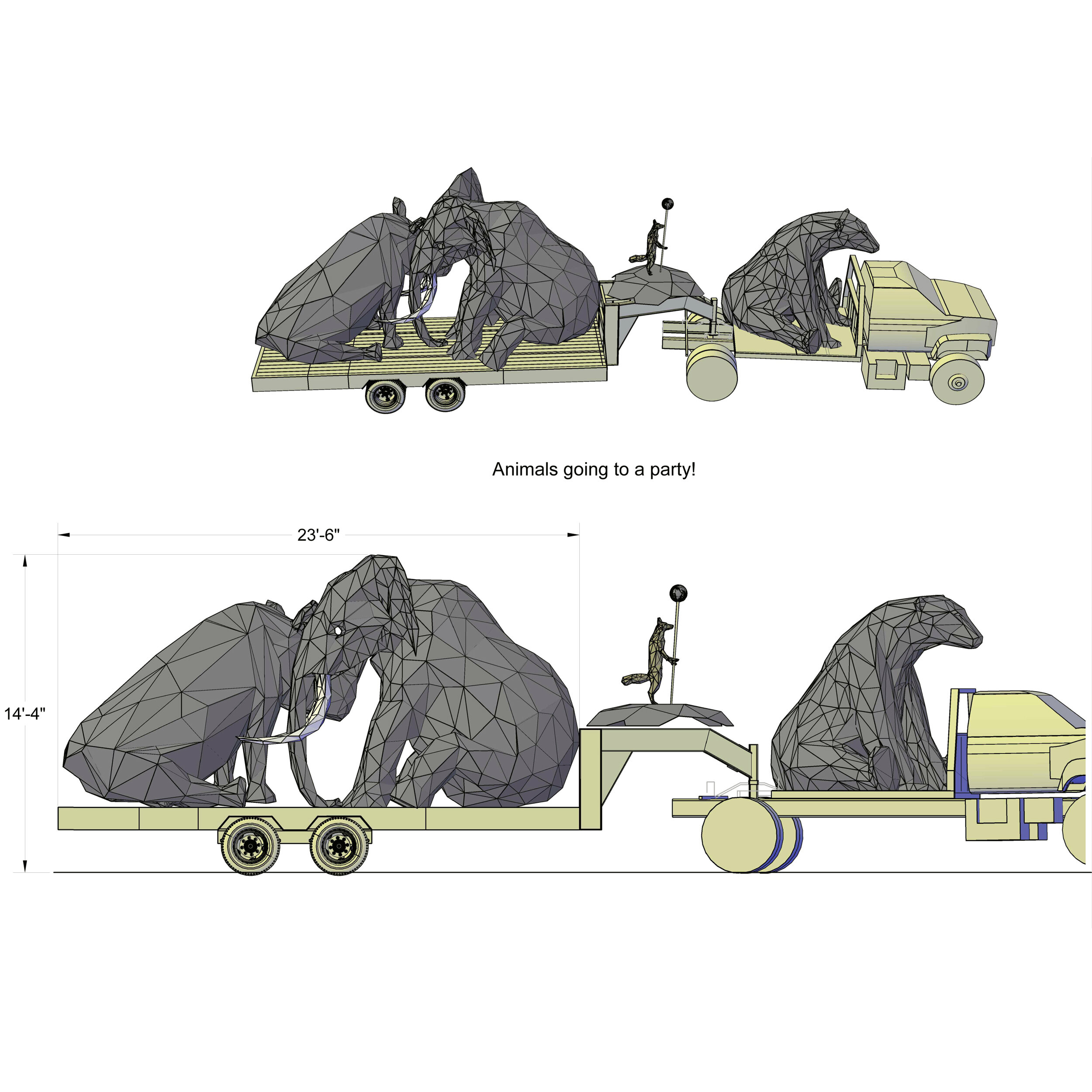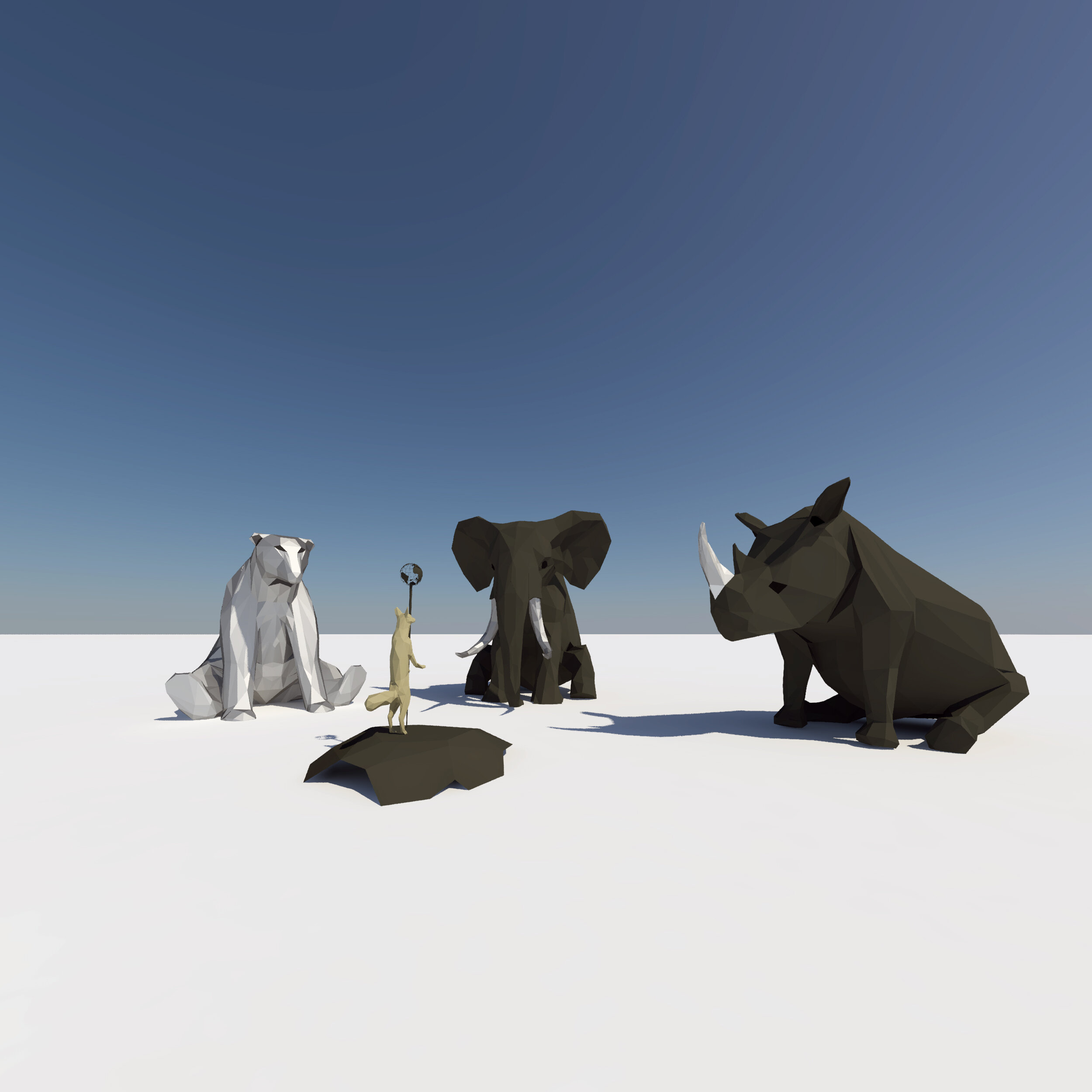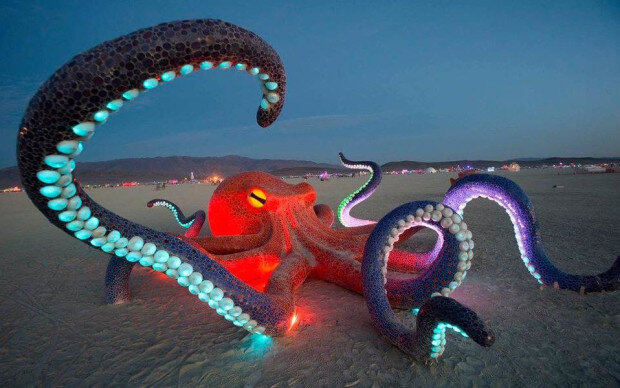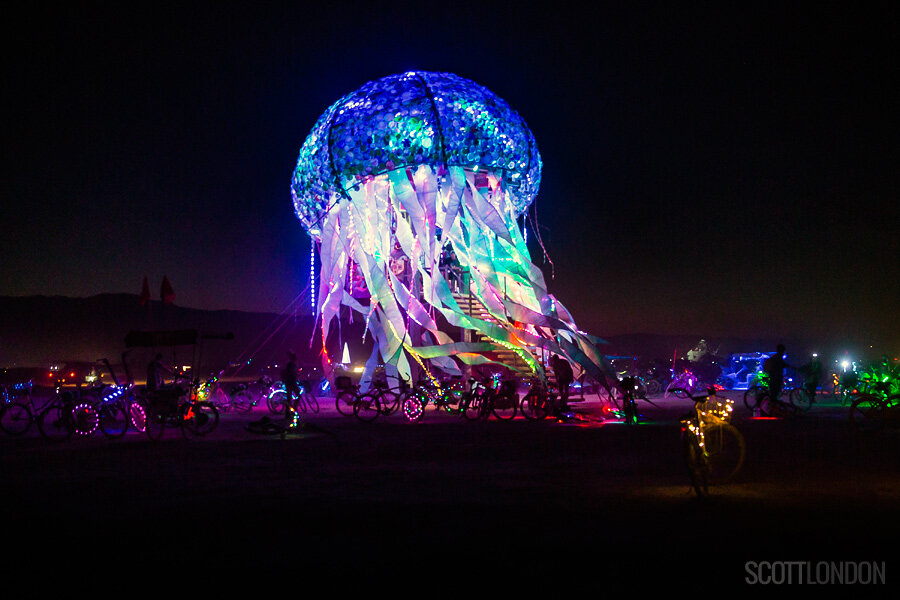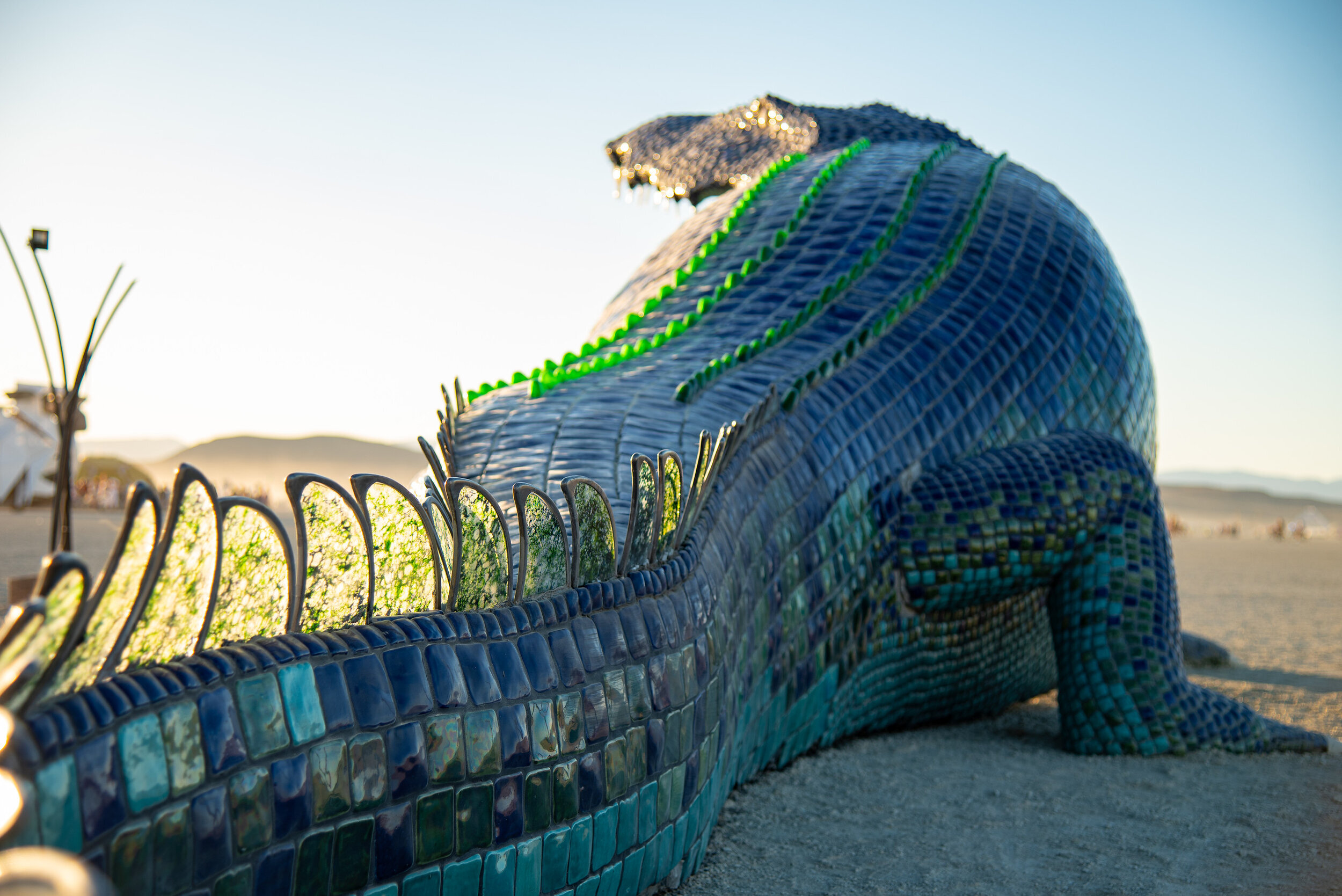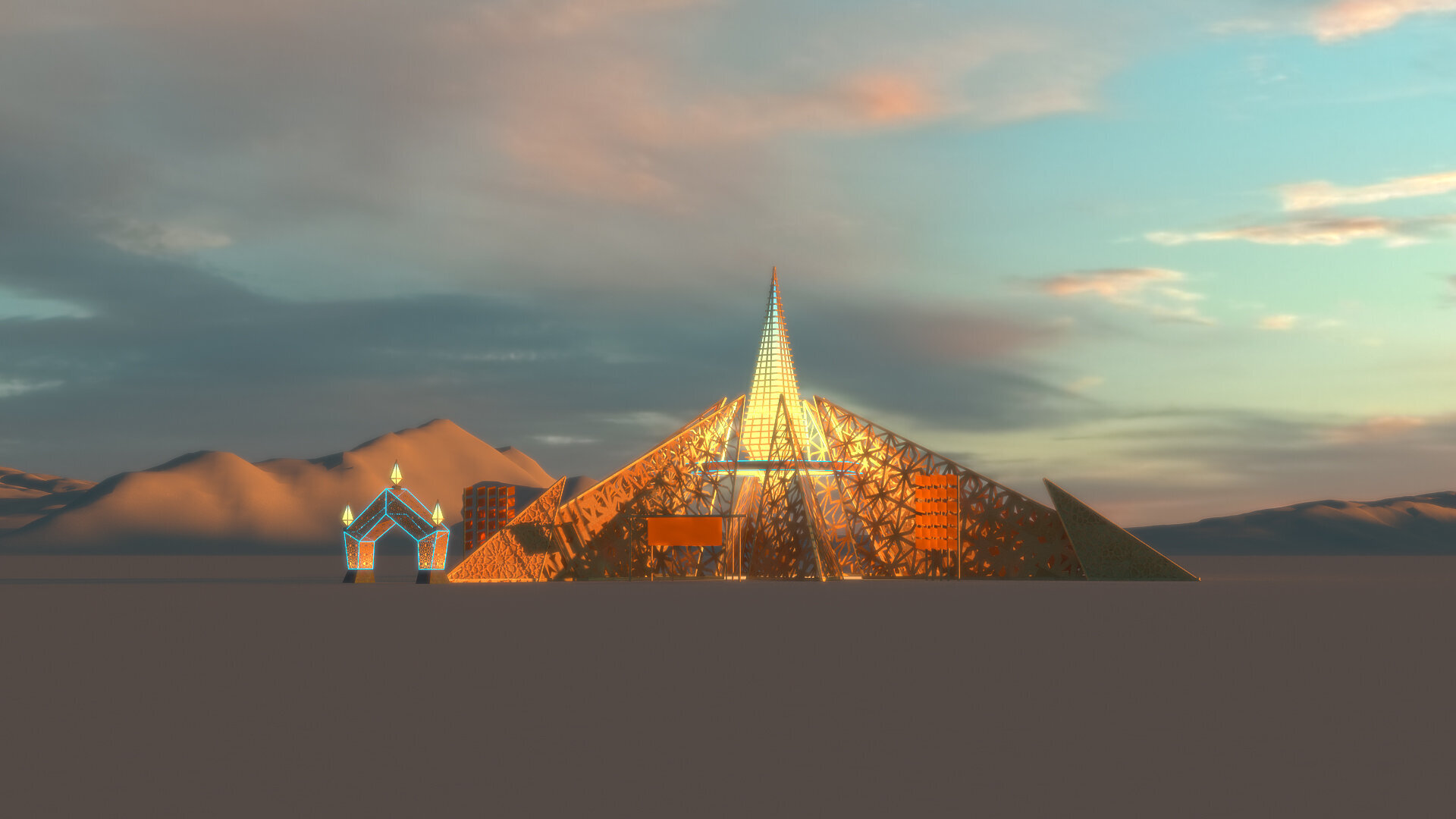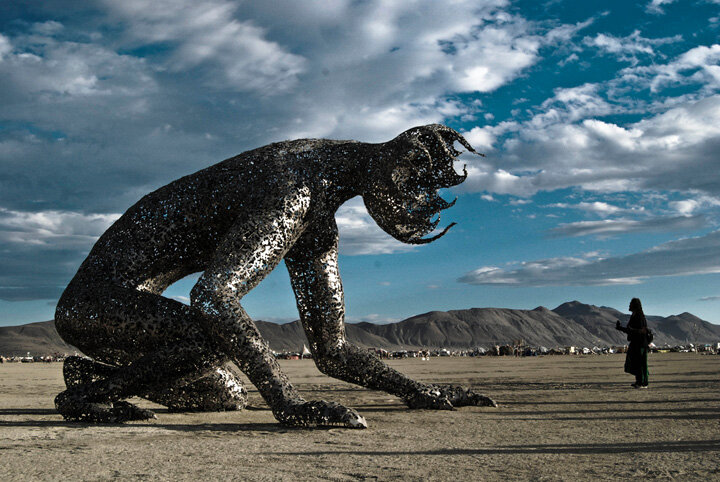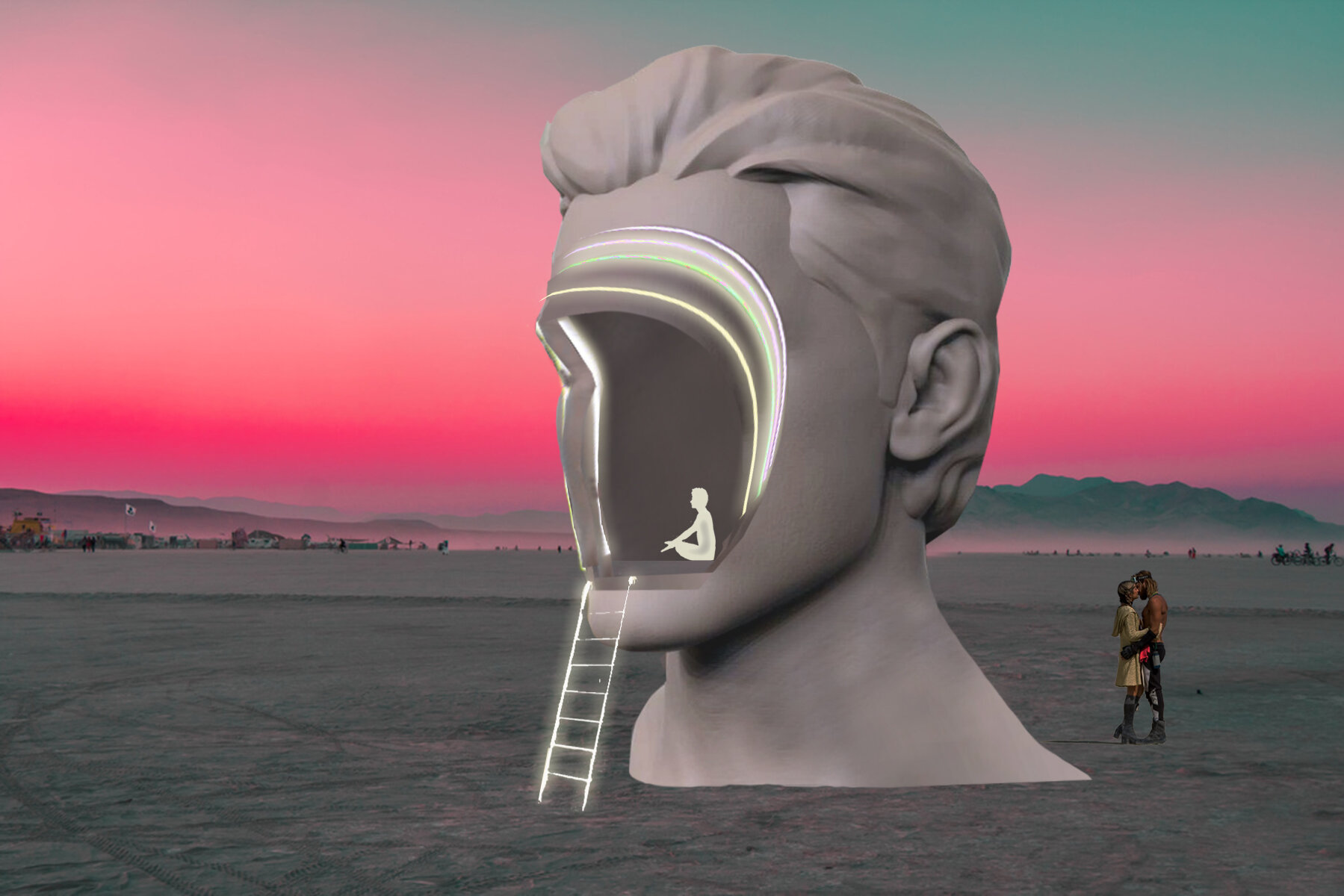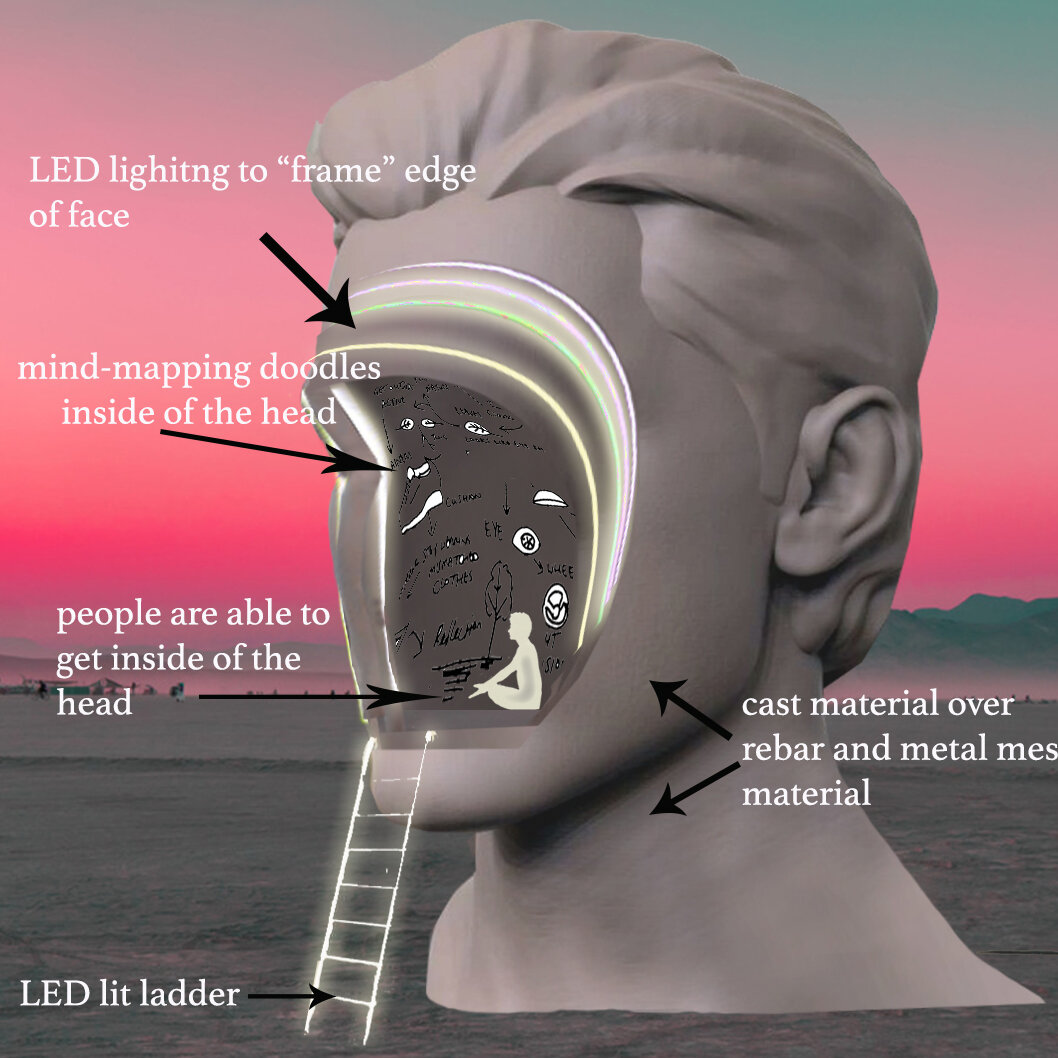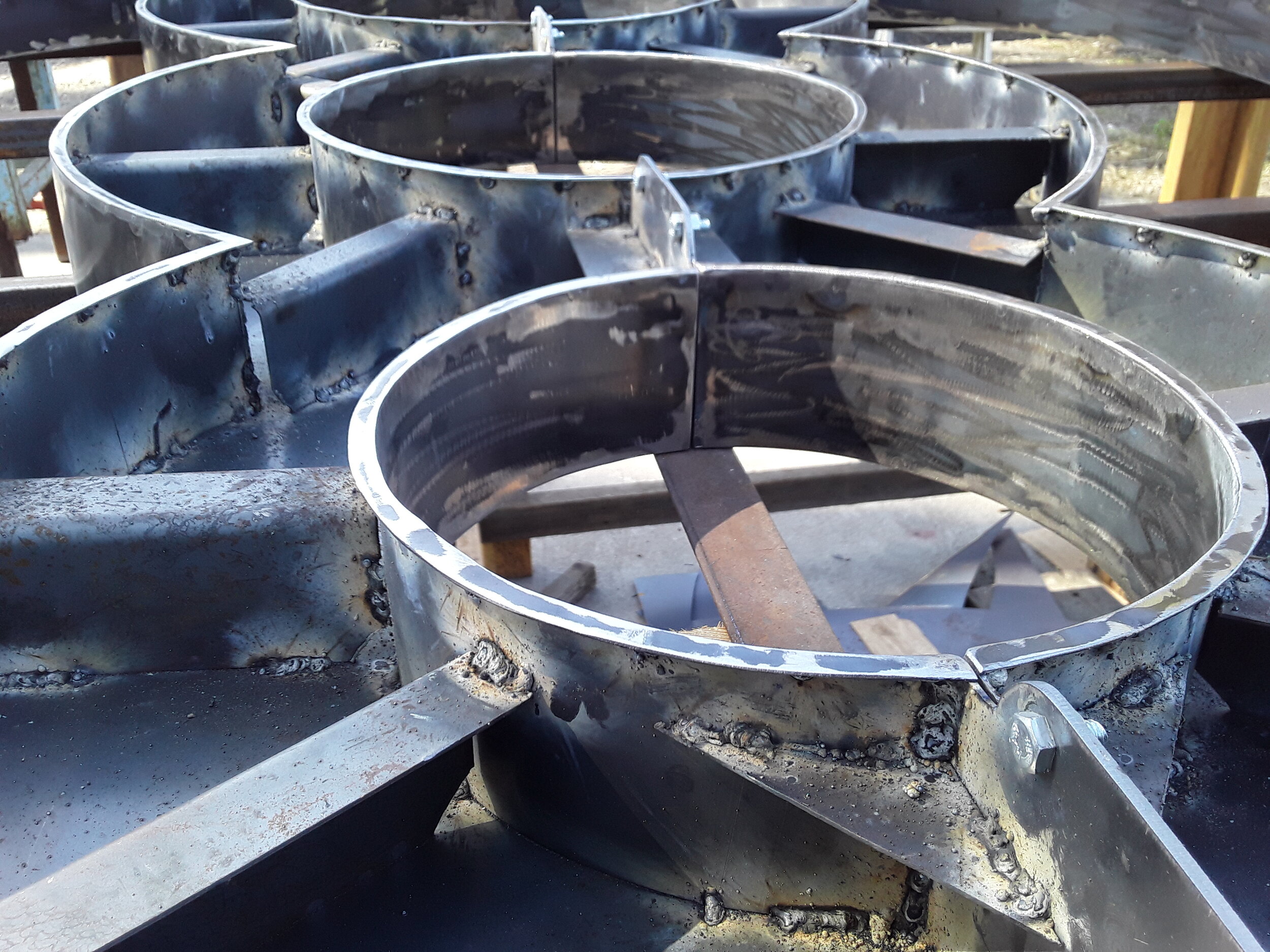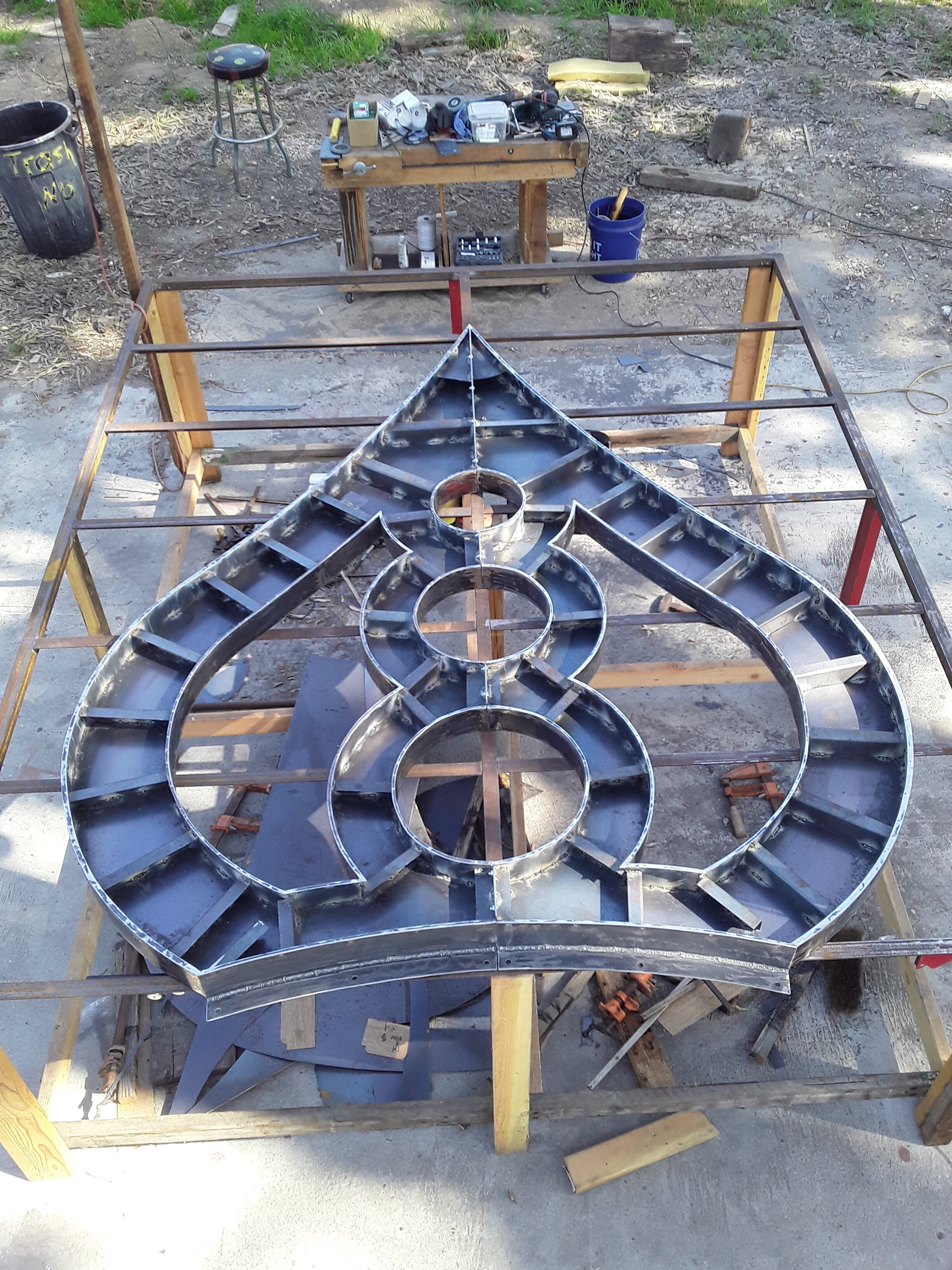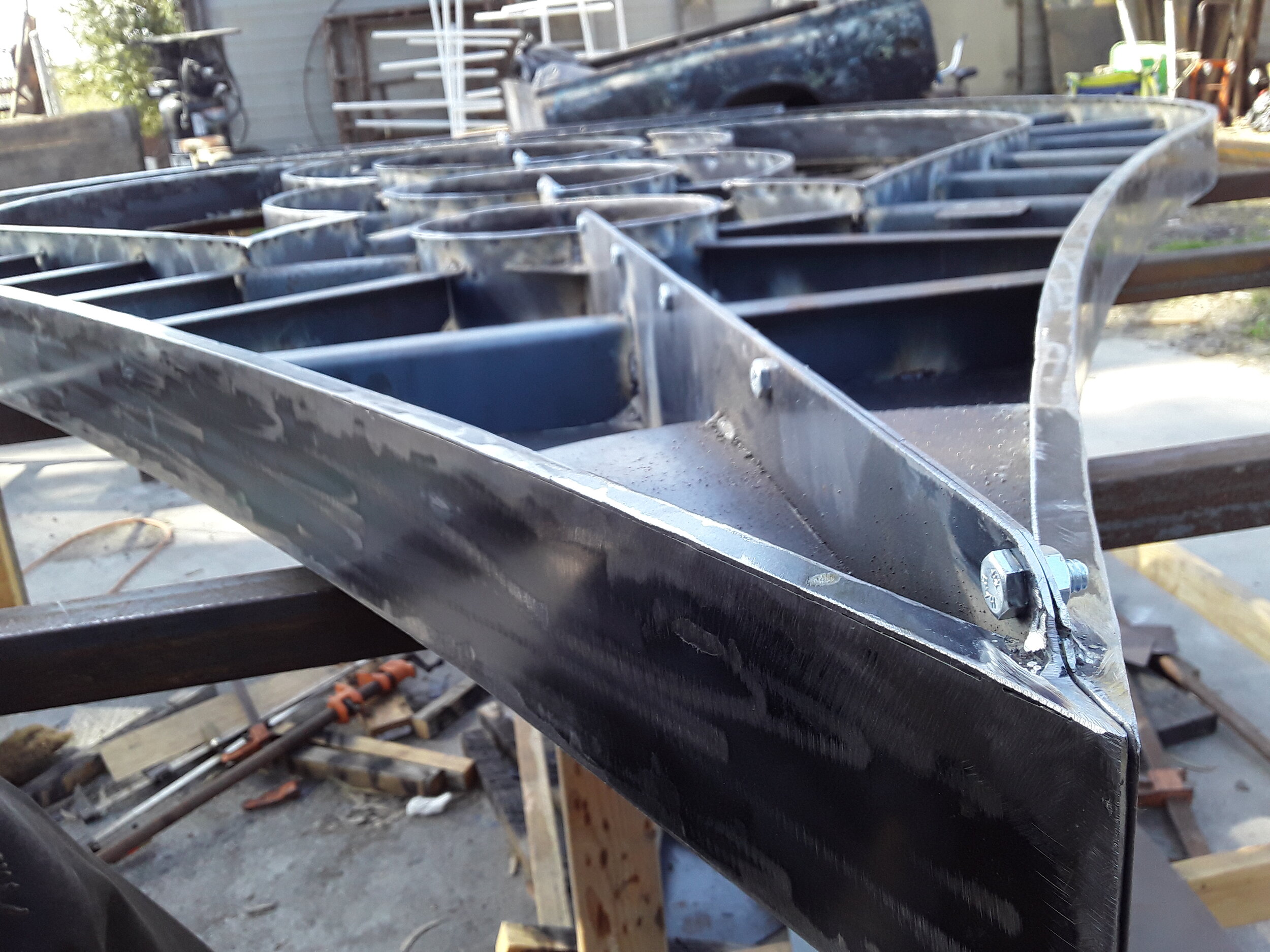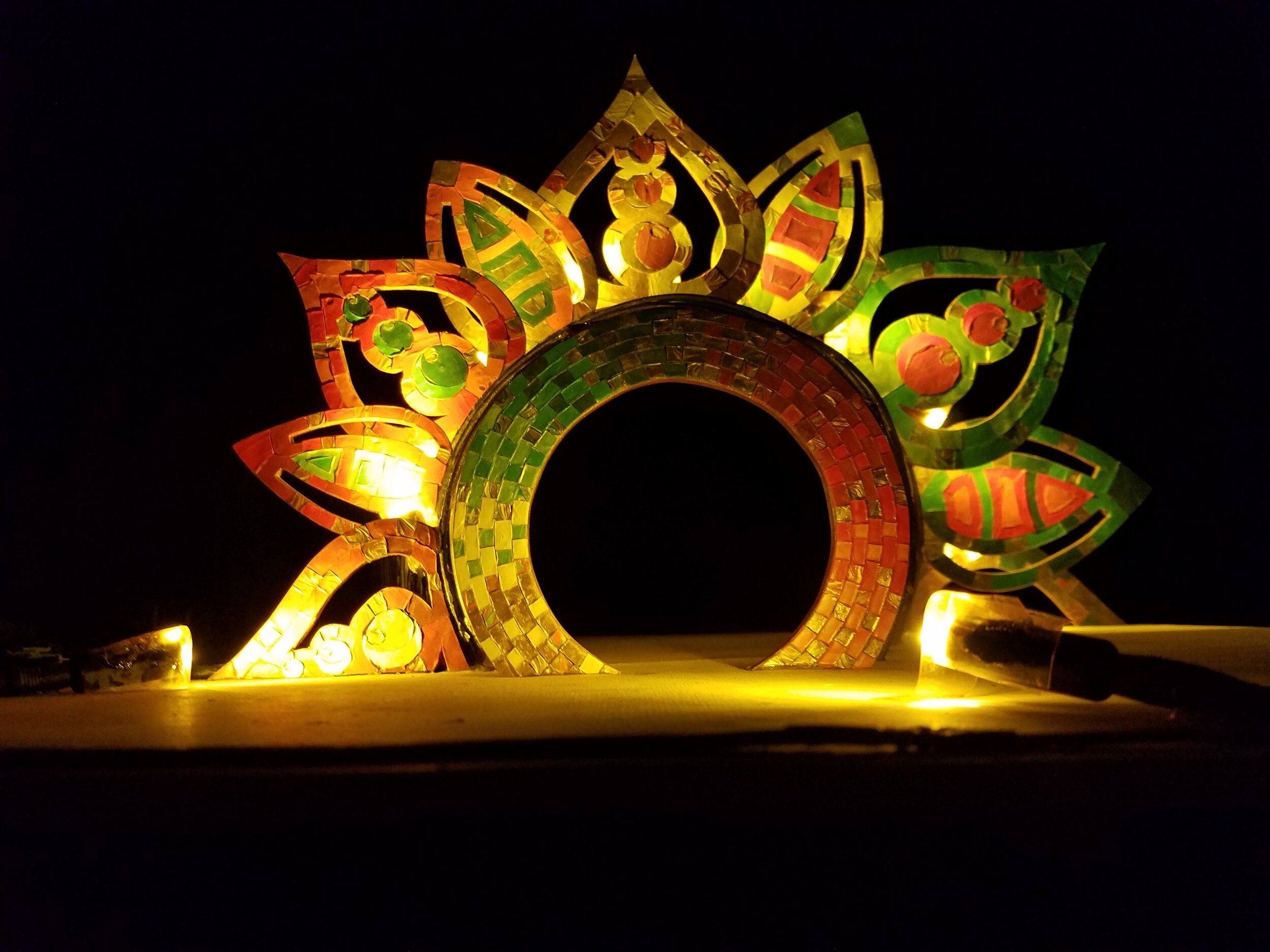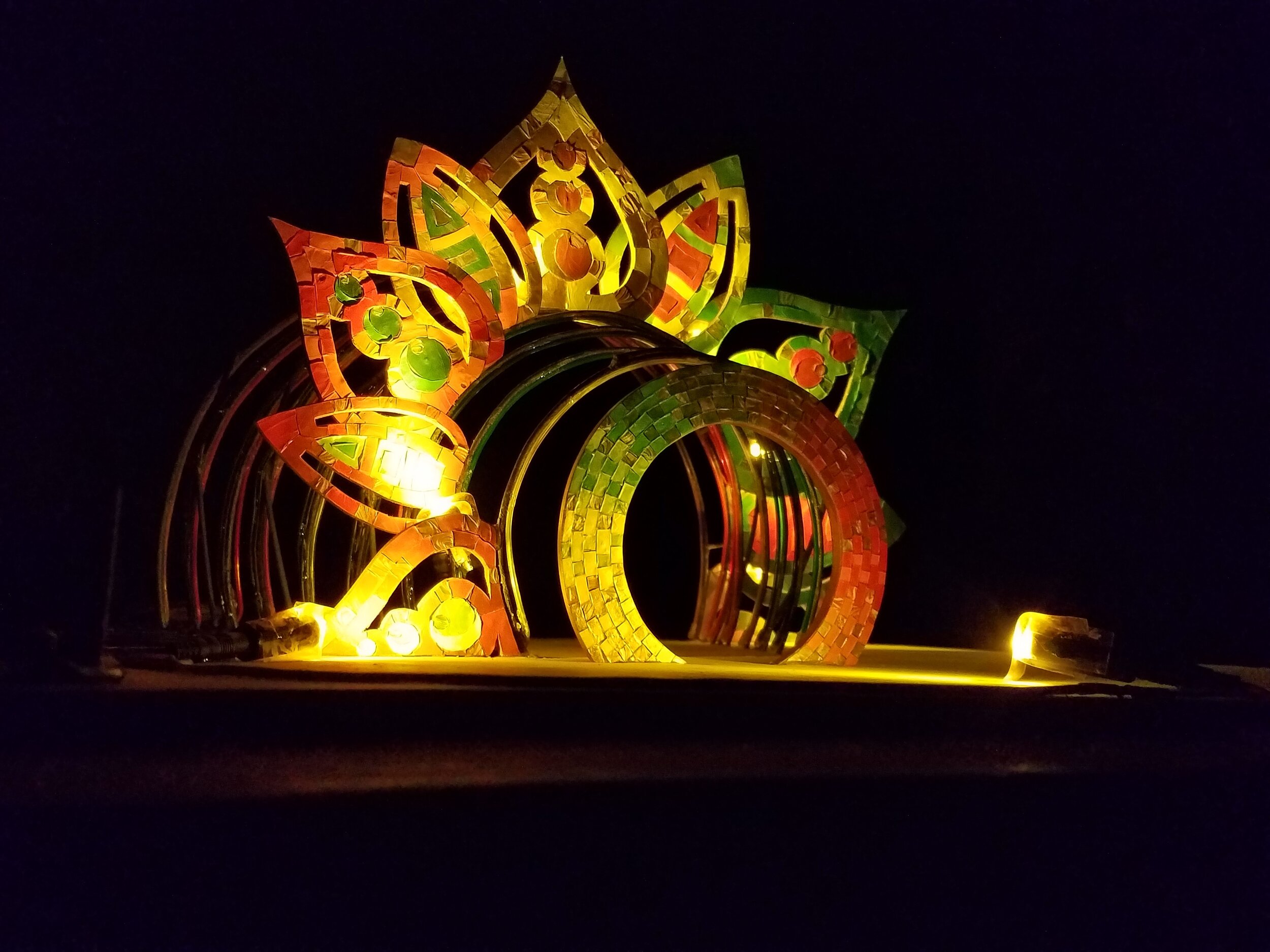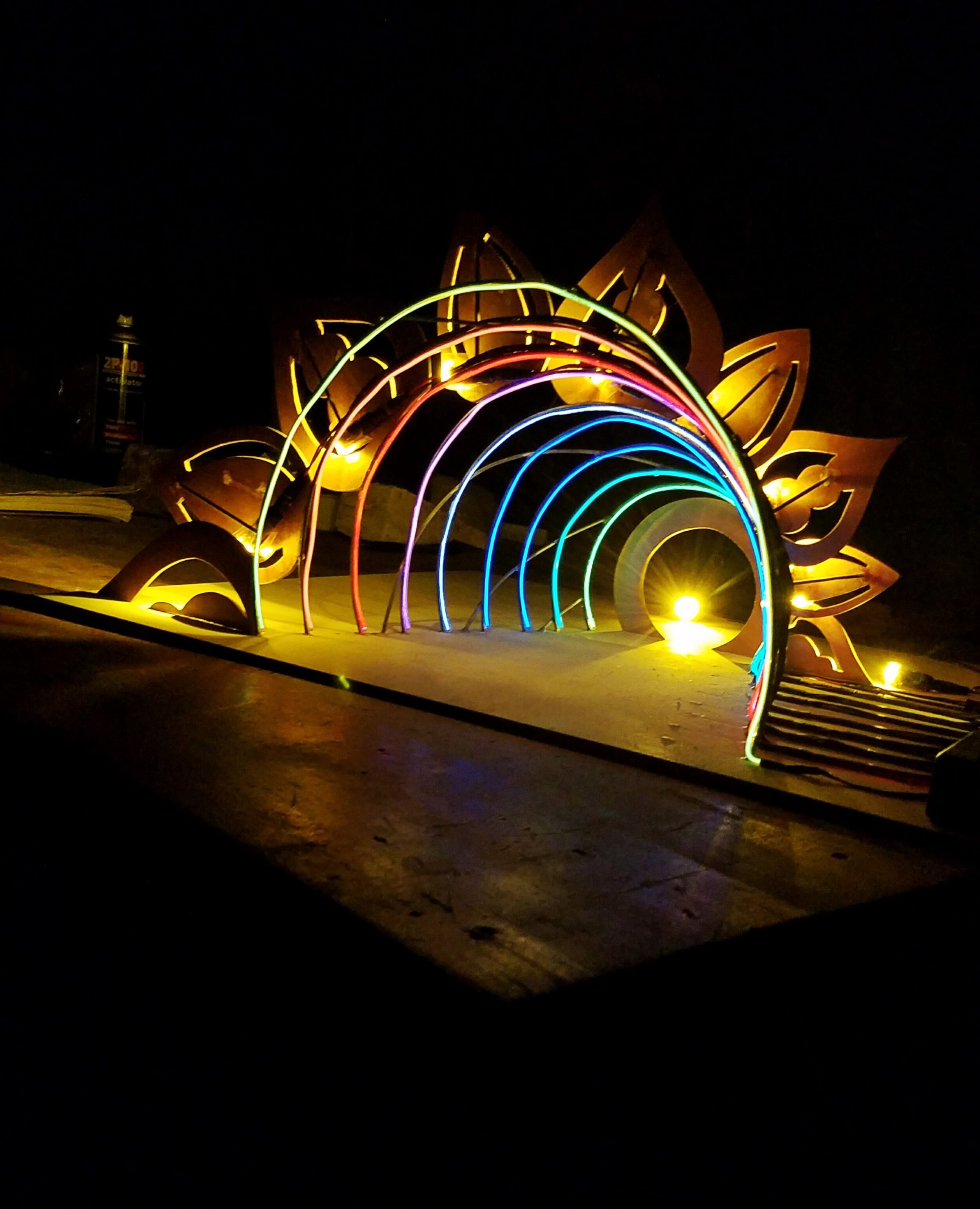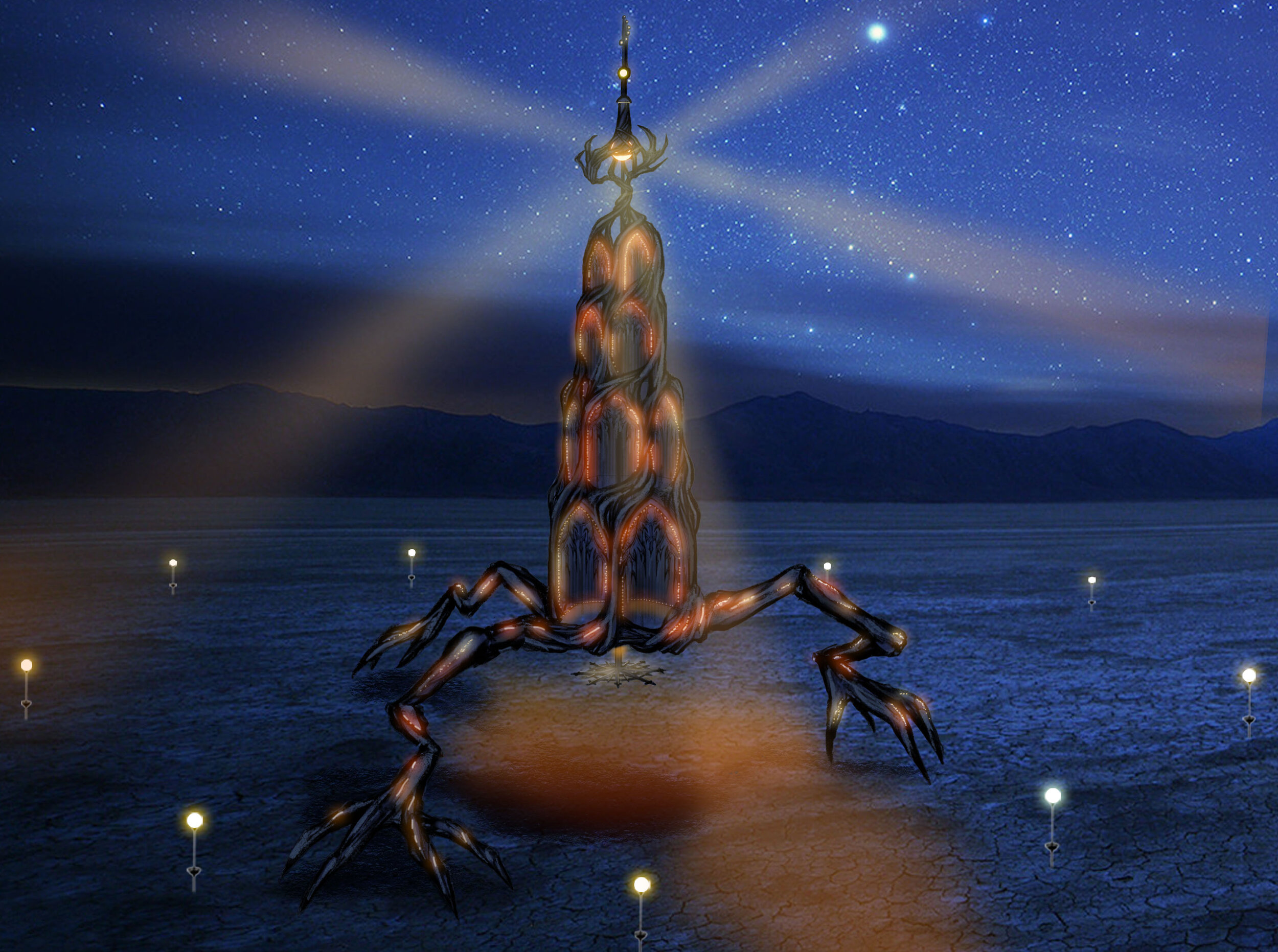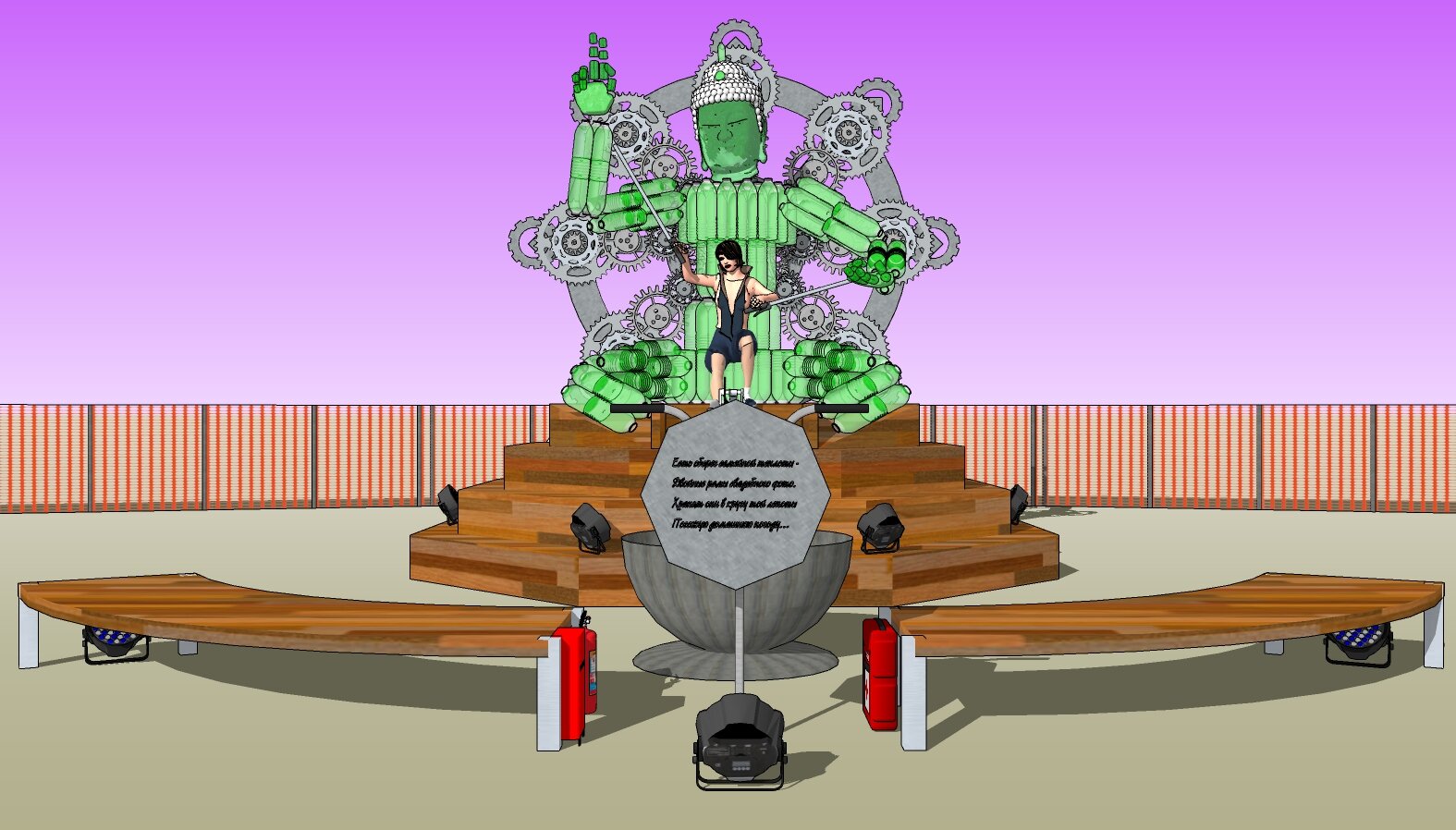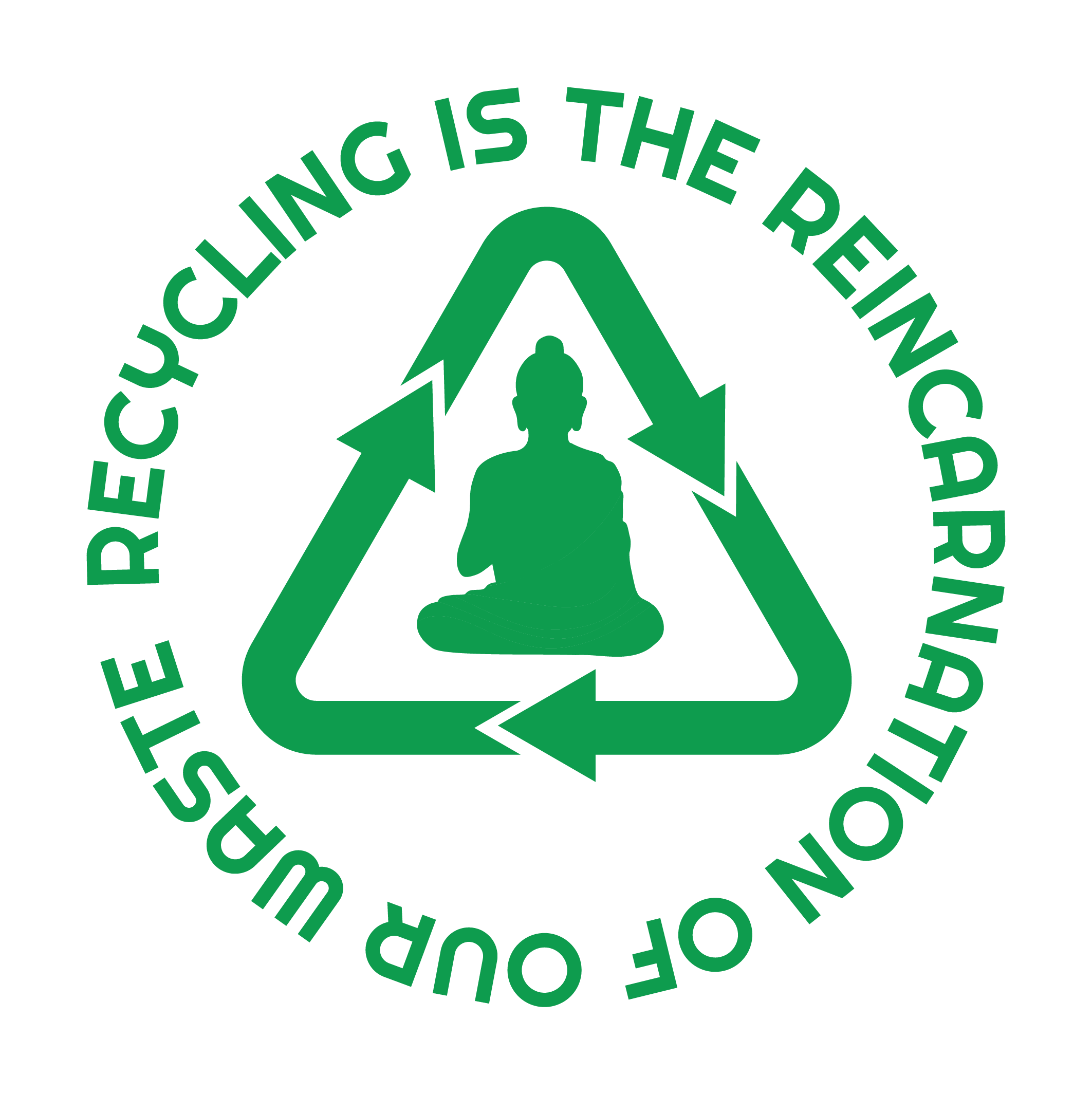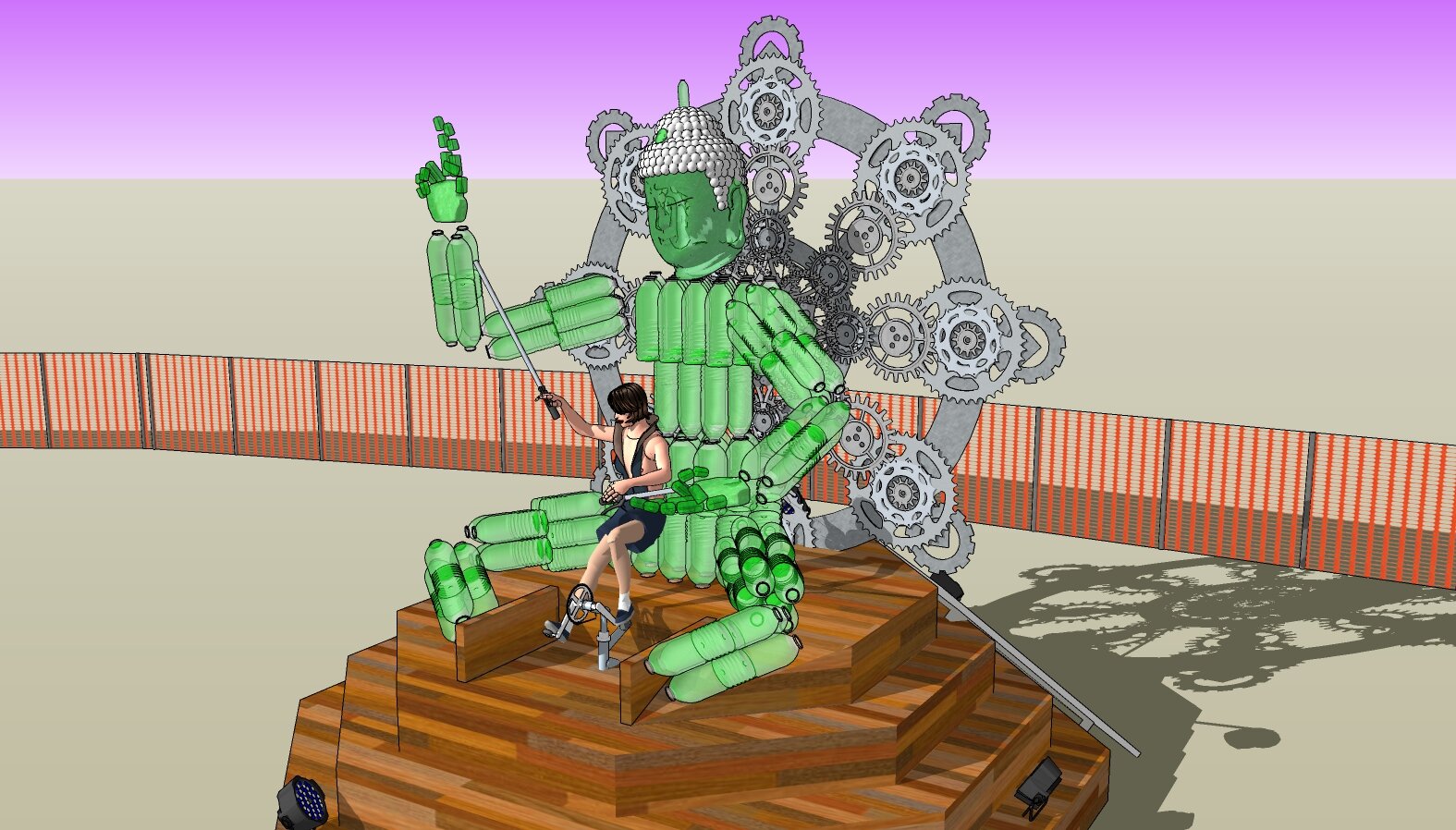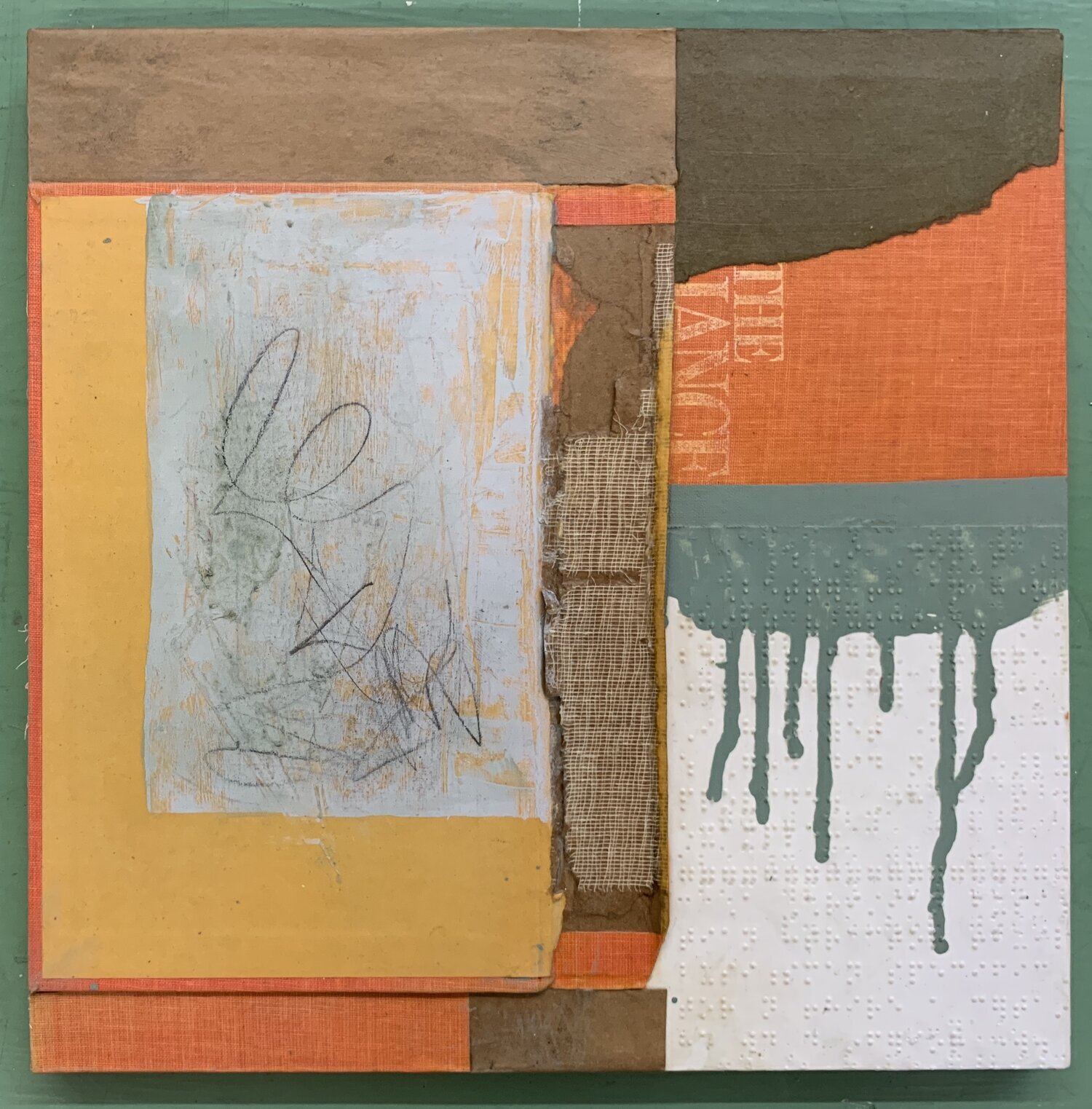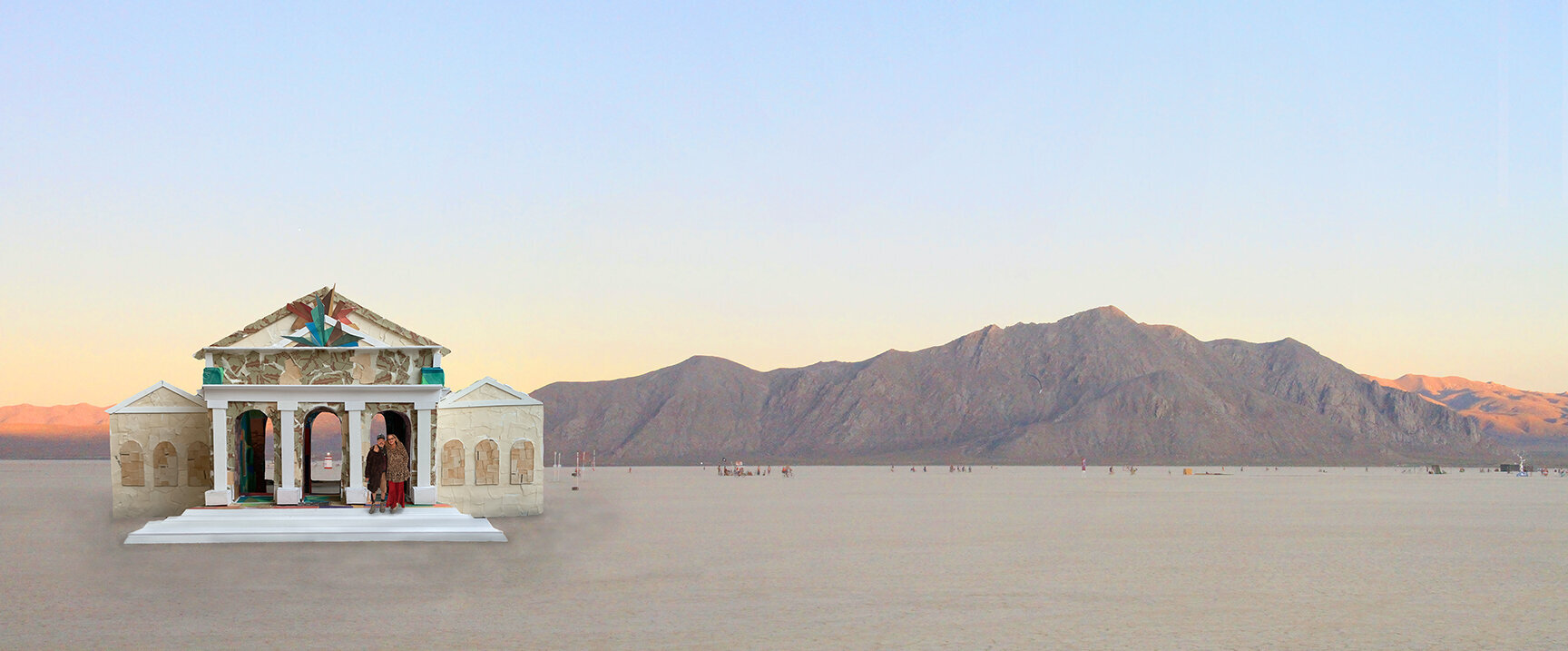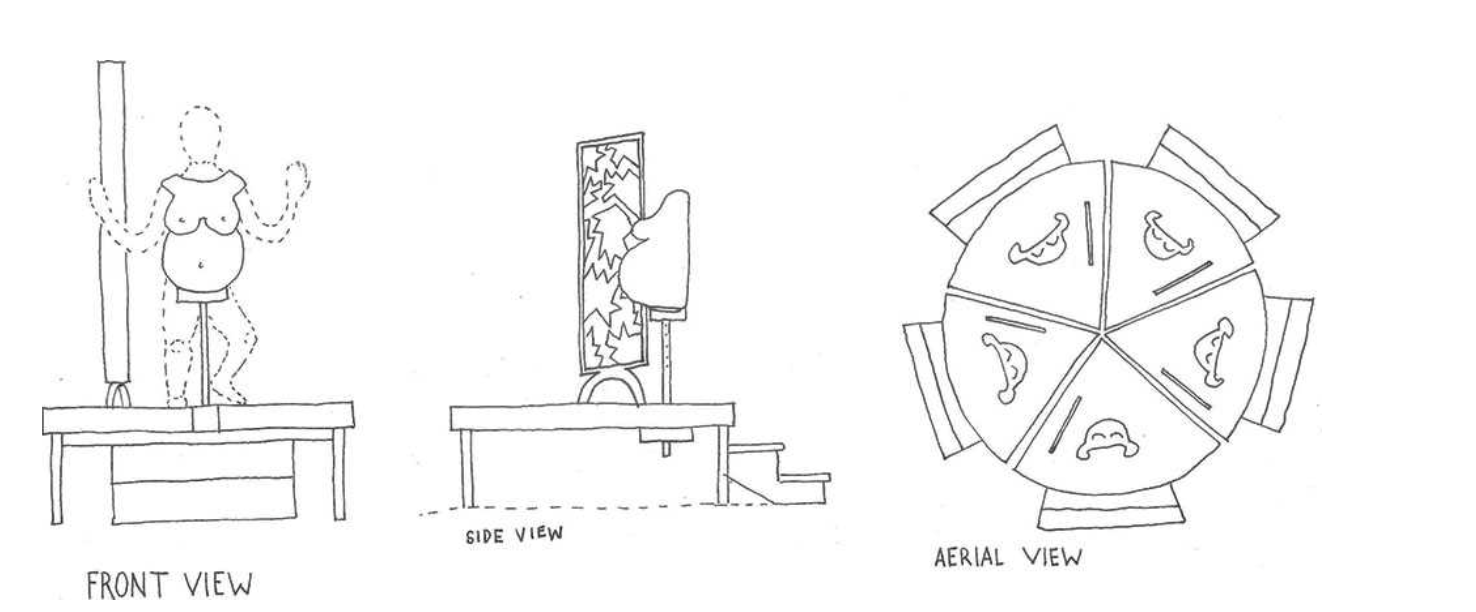2021 Burning Man State of the Art | The Art of Burning Man 2021 (The Great Unknown)
A LOOK AT THE ART AND ARTISTS OF BURNING MAN 2021: THE GREAT UNKNOWN
As of April 12, 2021.
We rely on artist’s submissions for almost all of our content. If you are bringing art to the playa, please let us know! If you are featured and want any changes to the description of your work, please let us know! We can best be reached via email.
Trippingly is a 100% non-commercial, zero revenue project built by Burning Man participants. Thanks for viewing!
1:44 Inter-dimensional Space Time Portal — Harlan Emil Gruber and TransPortals with Maraya — Taos, NM
Burning Man 2020 | Chapel of Babel by Mike Garlington with Natalia Bertotti and Dave Keane — Petaluma, CA
Harlan has attended Burning Man since 1999, and has created portals for the playa since 2004. Read more about his work in this 2012 article. This year’s portal is a collaboration with Maraya.
The 1:44 Inter-dimensional Space Time Portal will provide a place for the return of the Divine Blueprint of Creation through Form, Sound and Light. Based on the universal principles of the cycles and circles of time and space it is an environment to go within to experience the Codes of Creation.
Located at 1:44 on the Playa, two semicircular 22″ by 22″-thick arches 24 feet high and 48 feet wide are aligned to north-south and east-west. The central pyramid can be both climbed on and entered within, of which the geometry is based precisely on Mayan pyramids. Visually, from outside, citizens will see the Signature Patterns of the Timelines (a symbolic language) inscribed into three sides of the ring and all four sides of the arches and illuminated from within. Once inside the pyramid participants will hear The Codes of Creation (sung by Maraya, as given by the Elohim), either performed live or recorded and playing on a sound system in the interior of the pyramid. Through experiencing these sounds and vision, all of our multiverses through all lines of time will be available for remembering.
Donate to this project here.
Black Rock Station - Black Rock Transportation Company
Black Rock Station is a mystery to be unravelled. A classic rural train station built in the mid-1930s to serve Black Rock City and the communities scattered throughout the vast Black Rock Desert. The station has come unstuck in time, unstable and oscillating through various moments over the last 150 years and beyond, with ghost trains heard but not seen, an ever-shifting interior life, and a subtle narrative that cuts against conventional historical themes.
Adding to the authenticity of its visual elements, Black Rock Station is also a sound piece. Visitors hear freight and passenger trains approach and depart at real-life volumes with announcements and floating bits of audio and musical clues. As the station cycles through time, pausing briefly in one of 8 moments over a 250-year period from 1858 to 2110, visitors catch snippets of mysterious audio or video, or explore ephemera in the station.
Donate to this project here.
Carillon — Steven Brummond — Oakland, CA
Steve was a designer and the project manager for the 2017 Temple. This year, he is bringing Carillon to Black Rock. According the the artist, a carillon is a collection of bells suspended in a tower and played with a series of keyboards or levers.
The project creates an interactive carillon on playa with 100 bells controlled by a series of levers and ropes. Participants enter the structure and work together to make carol using the bells. Carillon is contained in a 36' tall wood structure, which participants can enter at the ground level. There they encounter levers, ropes, and a spinning pole. All of these devices control one or a series of bells each ringing a special note. The main tower is pyramidal in shape, but has a two pronged spire at the top. The panels that make up the exterior are made from recycled plywood slats arrayed to make an ornate pattern.
Donate to this project here.
Citipati — Ryan Mathern and the Charnel Lords Crew — Atlanta, GA
In 2017, Ryan brought Tonglen to the Playa (see below). This year his team is creating The Citipati, the Funeral Lords. What is the Citipati… read more here.
From the creator’s website:
The Citipati, the Funeral Lords enact the eternal dance of death within an arching fire of perfect awareness. Two metal figures, nine-foot tall skeletons forged and fabricated from gleaming steel, fearsome and flashing, dance above a stage, which is ringed with footlights. A sixteen-foot high arch of fire frames them, spitting flame into the sky. These charnel lords are animated by the air and propane sent through their limbs and features: clattering, spinning, shrieking and rattling in their wrathful dance.
Citipati — Ryan Mathern and the Charnel Lords Crew — Atlanta, GA | Image from Prayer Engine
Burning Man 2017 | Tonglen by Ryan Mathern | Photo: Prayer-Engine.com
Coalescence — William Nemitoff and Curious Form — New Orleans, LA
In 2019, William Nemitoff and Lindsay Glatz created dream swing. This year William will bringing a new work, Coalescence, with the support of a honoraria grant.
Coalescence is two larger-than-life symmetrical metal orchids with interactive lighting in the flowing petals, seating on the leaves, and an ambient soundscape. The lighting and audio soundtrack respond to proximity and density of the crowd.
Donate to this project here.
Burning Man 2019 | Cloud Swing | Photo: hanahou.com
Cosmos — Jen Lewin Studio LLC — New York, NY
Comprised of spiraling LED pathways, Cosmos is a traveling, interactive light installation that has been coded to sense and respond to impact, vibration and movement.
Spanning 15,000 sq. ft., Cosmos is the largest sculpture ever to be commissioned from Lewin’s studio and has been engineered to perfectly process human interaction.
As viewers run, walk, dance, jump and play across Cosmos, they are able to generate an infinite amount of changes to its colors and reflections. This allows for an unprecedented level of interactivity and transforms the way we interact with art and each other.
Council of Animals (What to do about the monkeys) — Quill Hyde — Tonasket, WA
Quill is an artist by nature, engineer by training (Columbia & Reed), and has been bringing art to Burning Man since 2007, after first attending in 2006. Acavallo was the first project, and that was the seed for an art support camp and volunteer base that makes these projects possible. His art is inspired by nature, music, kids, and a vivid dreamscape, and designed and built with 25 years of engineering and fabrication experience.
From the artist:
The Council of Animals (what to do about the monkeys) is a piece to encourage dialogue. Three large metal animals - an elephant, a polar bear, and a rhino - make up the judges. Coyote is here too, with his fancy burning earth talking stick, as lawyer. There are benches for the monkeys.
The three judges are faceted steel, their massive bulk and iconic character rendered in clean geometry. They're all seated, on their butts, focused on Coyote and the 2-leggeds. Coyote stands on 2 legs, like his clients, leaning on a fancy talking stick for support, and standing on a metal platform. His talking stick has a globe-themed burner at the top. Behind him are benches of reclaimed wood.
The sculpted animals are large and visually striking enough to draw people in, the benches provide a resting place for dialogue. Which is the real goal of the piece - under the focused gaze of the judges, the participants will be encouraged to have meaningful conversations about what we're doing as planetary cohabitants. Or just hang out and enjoy watching Coyotes flaming staff light up the sculptural forms. Or make some new friends. Of course, they'll probably want to climb all over the animals, and that's OK too.
Philosophy
It was a surprise, as a young person, when I realized that none of my classmates thought of themselves as animals, that they thought of themselves as somehow separate, superior, like we were dropped in from another reality. I grew up close to the dirt, with animals as friends and foes alike, as equals. So it was a shock, in that fifth grade classroom - wait, what? I've been thinking about it ever since.
I was also heavily influenced by the creation myths I read, with all of the capricious roles that the animals played. Particularly Coyote, as the trickster - some animals have benefited from us taking over, some animals, not so much. If they could go back in time and squash a couple key monkey-ancestors, would they?
So, this piece. To be judged, by the animals. We're all in it together, and better figure it out soon.
Donate to this project here.
Crotalus AKA “Freddie” the Mojave Green Rattlesnake — Peter Hazel — Reno, NV
Crotalus, aka “Freddie.” Freddie will be a 25-foot tall rattlesnake made of thousands of glass and ceramic mosaic scales. This year I will be adding a spectacular light show using LED lights alongside the back diamond glass patterns made of reclaimed whiskey, vodka, and some tequila bottles.
Freddie’s ribs will be exposed, facilitating an interactive experience where explorers can climb outside, inside, and all the way up the ribs and into his open mouth. Once there, they can relax with a view overlooking the Playa, while an exhilarating fire escapes from Freddie's nostrils.
Freddie's design pays homage to the local Great Basin Rattlesnake, eclipsing the Citizens of Black Rock City as he stakes his claim as the Playa’s rightful inhabitant.
Peter’s past projects:
DIPTOWN — Stanislav Shminke and Irina Shminke — Ekaterinburg, Russia
DIPTOWN is a sprawling landscape installation of a town buried in sand with only building roofs sticking out of the ground. Diptown was once a simply a local tourist trap situated in a dip. Something covered the town up to the roofline, and the dip was transformed into flat desert. What’s happend? Here we leave space for interpretation. Everyone can invent their own legend. We only present an image, and we invite people to give it meaning and stories.
Most of Diptown is hidden beneath the surface, in both the physical and metaphorical senses. Like an iceberg, it projects only a few feet above the surface. It will be up to imagine what else exists below the surface. It will up to viewers to fill in the rest of the details.
A note from the artists:
We are Stanislav Shminke and Irina Shminke, we live in Yekaterinburg city, on the Ural Mountains in Russia.
In 2018 we brought our art piece Glorywall to the Playa directly from Russia. We build it in Yekaterinburg, Russia, packed it in three boxes and checked it in luggage. This year we are going to build the Diptown in Reno.
We are seeking people to join us and help build this project. We have a volunteer questionnaire (Russian and English) here.
We would like people from the USA (and other countries to join us). We are not going to build anything in Russia, with almost all the work happening in America. We see Diptown as an international project in which everyone will find something of their own.
Donate to this project here.
FIRE — Zoe Fry and The Introverts Collective — Mill Valley, CA
The FIRE Installation is a grove of Manzanita trees killed in the Napa fire of 2017. The intention of the piece is to create an opportunity for a immersive and physical relationship to the element of Fire, to experience oneself as part of a community, a grove, and also to highlight the unique individual entity of each tree as a natural work of art.
A book of fire stories, 2D art, and scientific fact related to the fire element will be on a stand next to the grove. We will be collecting submissions for this book through September 2020. Submission requests can be sent to TheFireInstallation@gmail.com
Donate to this project here.
Fractal Droid — Jenna Finney and Fractal Droid Collective — Austin, TX
Fractal Droid will feature films produced by Dutch Visual Fractal Artist Julius Horsthuis and American Visual Fractal Artist Fractaled Visions (Keith Anderson).
This project will be an interactive sculpture to hold space for both inspiration and philosophy of the integration of man and machine; artificial intelligence, virtual reality and the modern day human cyborg. Technology is already an extension of oneself, it is only a matter of time before we are fully combined with our creations.
Gilded — Mr and Mrs Ferguson — Alameda, CA
Scared of snakes? Maybe not if you get close to this western diamondback rattler. As you are drawn in, you'll see that its scales are actually gilded flowers and leaves. Delightful to admire and touch. A deceitful serpent from the Garden of Eden or a creature of natures's beauty? You choose.
Harmonia — Roy Trammell — Beaverton, OR
From the Org website:
Chaos and Resonance. Cycles and Epicycles. Movement evokes sound. Forms are implied. Unexpected order arises. Harmonia is a highly interactive sculpture with spokes animated by light in harmonically related motion. It’s a 30 foot hemisphere of 64 spokes and 13,000 LEDs. A nearby touch screen kiosk turns it into a great big toy which can be played like a visual instrument.
Heave — Michael Christian — Oakhurst, CA
Michael Christian has been bringing large scale art to the playa since the 90s, including being the lead artist for the Nebulous Entity for Burning Man 1998. His work has often been among the most striking on the playa. He’s never been one to telegraph his work, but he notes that in 2021, he’ll be back with a 16 ft climbable structure of uncertain design.
KOILOS, Burning Man 2007, Michael Christian.
I Heart Mom — Ryan Stevens — San Francisco, CA
With this 20 foot tall wooden sculpture of the traditional style I Heart Mom tattoo, we hope to bring all the beauty, struggles, highs, and lows associated with Moms (or other loved ones) who have shown us true, selfless love. This is more of a dedication piece but not specific to one person, it can be anyone in your life that you love wholeheartedly and made you the person you are today. Unfortunately not everyone is able to bring those people out to BRC to experience Burning Man so this is a way to honor them on the Playa.
Donate to this project here.
Illumina Radiata — Eric Zann — Kirkland, WA
Illumina Radiata is a 36-foot tall sculpture inspired by the totem poles of the Haida culture in the Pacific Northwest, it will incorporate design elements and motifs from both Haida art as well as art and architecture from around the world, in an attempt to celebrate and showcase their diversity.
Donate to this project here.
Infinite Stare — Kelly Smith Cassidy — South Lake Tahoe, CA
"Infinite Stare" is a monumental sculpture of a faceless head. From the distance, the head will look familiar; as if a forgotten culture had created it a millennia ago. Framing the face are lines of LED lights.
The inspiration for Infinite Stare stems from a spiritual awakening that the artist had when she was 21. During meditation, Kelly had a feeling like she might die. She surrendered to this feeling and then felt a peace come over her. The boundaries of "self" dissolved, and she found herself in Oneness. Once her eyes opened, with the expansion still present, she looked into a mirror, saw her face and felt separated from it in a way. She said to herself, "huh, so that's the face I chose this time around. Interesting!" There as a sense of the psychological ego dropping away and the sense of self taking a back seat to higher self. Since then, Kelly's life has never been the same and she has strived to make art that conveys this message to others.
Where the face should be on the sculpture is an open area. A lit-up ladder or stairs lead up to the hallowed-out head where people can sit. Drawn inside the shell of the head are all kinds of mindful ideas with pictograms and such depicting thoughts and ideas. LED lights are within to further enhance the interior "thought".
In a way, this piece will reflect the same feeling and aesthetic the artists burnbot effigy, "Creu Hudol" made for the Man Pavilion 2018 as well as her 2019 Civic Plaza grant piece, "E Pluribus Unum : Out of Many, One", as if they all came from the same time and culture.
Kelly is a second-generation artist living in South Lake Tahoe, CA. She creates welded copper and bronze art pieces for a living.
Kelly Smith Cassidy Fine Art: http://www.KellySmithCassidy.com
2018 Man Pavilion Art Grant piece: Burnbot Effigy, "Creu Hudol (Magical Being)": http://www.CreuHudol.com
2019 Man Pavilion Civic Plaza grant winner installation: "E Pluribus Unum : Out of Many, One": http://www.BurningManPlaza2019.com
2020 Burning Man Honorarium piece: "Infinite Stare": http://www.InifiniteStare.com
Kukulkan’s Portal — Abram Santa Cruz and Liquid PXL — Long Beach, CA
Kukulkan’s Portal at the Toronto Light Festival | Photo: courtsey the artist.
Kukulkan’s Portal is composed of two geometric shapes, an acrylic merkaba (stellated octahedron) enclosed in an aluminum cube. The design is meant to show the geometric relationship between the merkabah and the cube.
Kukulkan’s Portal is a modular geometric sculpture in honor of the new discoveries made in mathematics and science. Although the cube and the stellated octahedron shapes are not new to mathematics, researchers have claimed to have invented a new class of equilateral convex polyhedra.
The merkaba is entirely constructed of translucent lexan multi-wall sheets encased in industrial strength resins. The “back” of the triangles will be lined with LEDs facing forward. The cube is made from aluminum truss and skinned with laser cut design of kukulkan and other mayan symbols. The cube also contains LEDs and can be controlled separately from the merkaba.
Abram Santa Cruz comes from Mayan descent via his grandfather on his father’s side. He comes from a tribe that is of Mayan descent about 2 hours south of Mexico City near the city of Puebla. Abram wanted to tune in with that part of his heritage in designing this project because of the spiritual meaning that the merkabah holds with various cultures from around the world and tying that into the spiritual Mayan symbology.
Abram Santa Cruz chose to depict Kukulkan’s image on the cube because of its encompassing theological meaning in Mayan and Aztec culture. “Kukulkan is the Mayan Feathered Serpent god of wind, sky, rain and Sun. He is also the creator that gave mankind his learning and laws.” Source. Kukulkan was also known to be the portal between the physical world in the spiritual world.
‘Spiritually, the Merkabah (stellated octahedron or dual tetrahedra), also spelled Merkaba, is the divine light vehicle allegedly used by ascended masters to connect with and reach those in tune with the higher realms. “Mer” means Light. “Ka” means Spirit. “Ba” means Body. Mer-Ka-Ba means the spirit/body surrounded by counter-rotating fields of light, (wheels within wheels), spirals of energy as in DNA, which transports spirit/body from one dimension to another.’ Source
“Since Plato’s work, two other classes of equilateral convex polyhedra, as the collective of these shapes are called, have been found: Archimedean solids (including truncated icosahedron) and Kepler solids (including rhombic polyhedra). Nearly 400 years after the last class was described, researchers claim that they may have now invented a new, fourth class, which they call Goldberg polyhedra.” Source . olyhedra falls into the Kepler solids category and worked as a stepping stone to the new findings.
Combining Kukulkan with the merkabah made perfect theological sense as we plan on adding a meditation platform at the center of the merkabah. By providing a meditation platform, Kukulkan can take the visitor on a journey into themselves and transcend into higher realms.
Loop — Dan Rabinovitch and Aromatic Designs Unit — Brooklyn, NY
Loop features a human powered fly wheel, that when activated creates music and coordinating lights.
Lost Frequencies — Shelby Dukeminier — Las Vegas, NV
Shelby creates large scale art and is bringing her first large scale project to the playa, an 18-foot tall heart. The idea originate when her mother, with whom she had not spoken for some time, posted an image of a whale heart on social media. The two reconnect after that, and the piece is named Lost Frequencies.
Donate to this project here.
Lux Lepus — Jen Law — Renton, WA
Mebuyan — Leeroy New and Pinto International — Manila, Philippines.
Leeroy New is an artist-designer whose practice overlaps and intersects with film, theater, product design, and fashion. He has created large scale public art (pictured below)
Donate to this project here.
Mebuyan — Leeroy New and Pinto International — Manila, Philippines.
M-Theory Mechanica — Matt Parkhurst — Truckee, CA
Matt Parkhurst, Ant.
Parkhurst operates MJP Fabrication and Mechanical Services and his motto is: “If I can’t build it, or fix it, it’s probably not worth it.”
Parkhurst has collaborated on several pieces for Burning Man over the years, including multiple arts cars and he worked on Steve Atkin’s “Fire Spire. In 2020, he will be creating a piece entitle M-Theory Mechanica for the playa, with the help of an honoraria grant.
Orbit — Hayden Harrison — Oakland, CA
Light and sound immersive experience.
Parallel Self Embraced — Matthew Pagoaga — Los Angeles, CA
In brief: We live in tumultuous and divided times. Our relationship to each other today is often one of disagreement, strife, and tribal mentality. Parallel Self Embraced presents an alternative - encouraging a coming together interpersonally. The piece forms a sort of abstract mirror. Identical on either side, participants step up to it and see the person across from them. Within an infinite number of universes, in an infinite number of timelines, all events are possible, and in infinity, within some space and some time, you are me and I am you. Parallel Self Embraced thus functions as a looking glass through which to see a partner, a friend, even just a stranger, as a reflection of the self that could be, and the beauty inherent to the person traveling in a world parallel to yourself.
Physical description: Twin 12' by 12' square panels made of welded pipe and conduit stand parallel, a foot apart, with wooden stairs leading up to the center of each panel on either side. Lines of the structure radiate from the outside of the square inward toward human-shaped negative spaces. Parallel Self Embraced is an outdoor installation. By day the piece appears as an abstract dark metal sculpture with lines radiating out. By night, LED pixels along the radiating lines light up. When a person enters either of the human shaped negative spaces, they trip a variety of interdependent Arduino sensors (eg. proximity sensor, photoresistor tripwire, pressure sensor, etc.) that connect to the LED strands and audio processors. Discreet speakers provide a daytime interaction element and lie beneath the stairs of either side.
Philosophy: In viewing the twin panels of cycling LEDs, I wish to show where our realities meet. These are the borders between my universe and yours. I want you to see those two realities – see that they are both beautiful and, if you wanted, we could bridge the gap between your universe and mine. There are rewards for doing so. I’d like to stress, however, that I don’t wish the piece to encourage a drift toward centrism or middling. The outer limits of our distinct universes – the breadth of my experience opposite yours – is likely infinite. In an infinite spectrum, “center” loses all meaning. This doorway and potential connection therefore exists at a point of found commonality and shared experience unmoored from tethered points of political or philosophical alignment.
Donate to this project here.
PeepShow: Land of Lost Encounters — Ashley Stracke — Los Angeles, CA
PeepShow will be a two sided-vaudevillian-style theater in the deep playa. Enter on one side and you’ll go rowing down a river of an ancient rainforest, hopping frogs, snakes slithering up trees, and monkeys climbing overhead. However, enter the otherside, and you’ll be treated to a show of an unsuspecting “actor” rowing down a river.
Pendulum of Fire — Pyrokinetics — Sebastopol, CA
Burning Man 2005, Pendul-up of Fire
In 2004, the Pyrokinetics team built a flaming pendulum from a framework of rolled tubular steel, copper and brass. The pendulum was suspended from a copper-tube umbilical cord that both provided support and sent propane to the solenoid discharge valves. Each solenoid valve had a pilot light at the end. The activation of each solenoid thus created an instant flaming jet effect, propelling the pendulum in the direction opposite that of its discharge. The four jets were oriented in a north-south, east-west configuration, allowing for directional control of the pendulum. The "pilot" uses four buttons to actuate the jets and drive the 20-ft-high pendulum, swinging it in whichever direction feels right.
For Burning Man 2005, continued the exploration of pyrokinetic sculptures and were granted funding to build a companion piece for the 2004 Pendulum of Fire. Using similar construction techniques and materials, the new sculpture took the idea of the pendulum and expanded on it by turning it upside down and adding a counterbalance, bringing the fire almost 30 ft overhead, making the Pendul-up of Fire.
PETALED PORTAL — David Oliver — Ventura, CA
David Oliver brought the memorable Portal to Burning Man 2019. In 2020, he returns, empowered with an honorarium grant, to create Petaled Portal.
Petaled Portal is an interactive sculpture. The experience begins by standing at a “vanishing point” where one is able view all of its petals at the same scale. This point is 27 feet (8.23 meters) from the entrance. Stepping away from this viewing plane one will notice the back petal is double the size of the first petal. More steps create an additional play on perspective intended for playa.
On the center ring of Petaled Portal, stained-glass tiles have colors that flow in the traditional way that a color wheel does. The Portal’s petals are also lined with stained-glass tiles, with colors flowing in the opposite direction of the ring’s colors. The Portal’s body is steel and painted copper. When entering from the back one will experience a decreasing rainbow tunnel of color not visible from the front.
Petaled Portal is a game of perspective exploration. It is up to the participant to find the vanishing/viewing point and experience all petals in alignment. It is also a tunnel to walk through, and a piece to experience from the inside. And to examine its exposed skeletal structure, through its many engineered details. To climb on. To experience backwards, and walk through a tapering rainbow tunnel of lights not seen from the front. Or from far away, to experience as a spiraled color of Petals.
Whichever way one chooses to interact with or view it, it is a Portal, offering the possibility of powerful "transformational" properties one can harness in their own personal way. It is a vessel providing transparent transportation for those willing for a transcending transformation.
Petaled Portal will be a landmark attracting awareness through beauty, reaching with its petals through space that is empty. Through space that is nothing, and nothing is something when everything goes… away. …to a place where pain is outgrown, where words become crutches and there is no phone. It's where we are together when we are alone. A destination that is truly home, a settlement of ones searching soul.
You can follow the project on Facebook. And on Instagram:
Donate to this project here.
Play With Your Food — Bryan Saunders and P Canadensis — Alberta, Canada
This immersive, multi-sensory playground is at first ordinary looking... but close up, viewers will be surprised with a birthday cake slide, a coffee cup merry-go-round, & a watermelon seesaw.
This installation is designed to allow us to re-imagine the everyday sights, experiences, and smells (wait, what?) we take for granted by presenting them in a fun, interactive, and larger-than-life format!
You can donate to this project here.
Prism of Possibilities — Emily Nicolosi and the In Theory Collective — Cottonwood Heights, UT
A multi-dimensional portal (a zome spinning the stars and flostam of humanity) invites citizens into a universe of potential climate futures. Spinning outward, the portal directs participants to explore three different domiciles, from best to worst case scenario climate-impacted earths.
Post-Apokalipsa Domo (P.A.D.)
Philosophy: Our world is barreling towards a future of 4 degrees warming by the end of the century: the worst-case scenario described by scientists of the Intergovernmental Panel on Climate Change. And yet, we continue to live the status-quo of exorbitant fossil-fuel combustion. Perhaps our inability to act is related to our inability to imagine potential futures. This art project attempts to dislodge our taken-for-granted understandings of one of the foundations of our lives: the very places we call home. Can we together re-imagine a future that maybe is actually even better than the present? What will it mean if we do not? If we can find hope in such an exploration, perhaps we will find the motivation to make moves in a direction that will allow a happy future for the earth and all of her inhabitants.
Description: The proposed installation is centered around a zome (a pointed, swirling dome). The zome will be made of steel treated with rainbow petina. The actual steel structure of the zome will not have large visual impact, as it will be covered in what represents the flotsam of humanity swirling through a multi-dimensional portal. The visually alluring and fascinating portal will be represented by spiraling dichroic plexiglass squares, and the flotsam will be made of pretty, shiny “garbage” including: CDs, keychains and can tabs, bike parts, silverware, seaglass, plexi mirrors, etc.
The zome will be surrounded by three structures that represent homes (“domo”). The best-case scenario domo will look very futuristic: plexiglass and shiny metal siding. The worst-case scenario domo will look like (and be) made of junkyard materials (with care to not injure participants with e.g. rust). The mid-case scenario domo will be made of upcycled materials, and partially decorated with mosaics.
Interactivity: The citizens of BRC will by stop to both enjoy and explore the P.A.D.’s interior and exterior, those who are fully engaged may uncover the story it tells. The exterior of the zome will be visually striking and beautiful to invite participants closer. The interior of the zome will have clues for participants to explore the mystery (e.g. written and artistic) and relaxing nooks in entice participants to linger and go deeper into the narrative. Each domo represents a different Representative Concentration Pathway (RCP), or scenario of potential future climactic changes, developed by the Intergovernmental Panel on Climate Change. Each will give exterior visual clues to the story, comfortable pillows inside allow participants to hang out and explore the decorations and stories (written and audio) that reflect each climate scenario. This project is at its core interactive and participatory. While citizens may not interact how we’ve designed, at the least the materials used in the project may encourage reflection on our culture of consumption.
You can donate to this project here.
Quadrupod 2.0 — Scott Parenteau — Sacramento, CA
Ratchetfish — Barry Crawford — Elko, NV
Rearing Horse, downtown Reno | Photo: Chris Petrell
Barry Crawford uses metal to create magical sculpture. In 2018, he brought Rearing Horse to the playa (pictured in it’s current home, downtown Reno).
This year Barry is bringing Ratchetfish to the playa. Ratchetfish will be a mechanical fish, that swims in a circle, with mouth movements (and possibly other movements), all controlled by hand cranks on the perimeter fence.
The cranks will generate a signal which is read by a computer to determine a desired speed and direction for the motor each crank is linked to.
Ratchetfish will have about 30 body sections (instead of 7 shown in the protypes below), so it will be a smoother motion. Barry is also planning a scaled body rather than the full height plates the prototype has, which should make for a neat effect.
Barry will be posting regular updates as he builds on his Facebook page, here: https://www.facebook.com/Crawford-Metal-Works-121838007852318
Secretly Abandoned Spaces — Valerie Elizabeth Mallory and the They Collective — Oakland, CA
Story
Every abandoned space retains a feeling of what it once was; a library, a railway station, a beautiful house. When stripped away of all the added things, we see a different kind of beauty, one that is forsaken and left adrift. It is the loveliness of both the unborn and unwanted. This piece is about the beauty of loss and decay of a space, a community, a loved one. The world takes back its own. Elegance emerges from loss and tells the story of predicted and necessary change.
One enters the old house where mortals used to live and create stories of their lives. The house becomes a church of collected ideas long passed. These souls live in the walls of haunted spaces. The space will be ornate as a structure of antiquity. People tell the old stories over and over in their lives. Secretly Abandoned Spaces is an ephemeral
museum, a piece that tells the story times lost in antiquity. New stories will be written on the walls which are meant to emerge out of the decay.
Created by Artist and Sculptor (Valerie) Elizabeth Mallory and Illustrator and Concept Designer Mikell Haynes. They reside in Oakland California and are driven by strong interest in art and strive to create unique diverse experiences. In Elizabeth's words: I make my art because I love expression and I love the nuances of communication. I work very hard to convey as much expressive feeling in a way that is uncluttered and pure. I am inspired by people in my own life, and patients I have worked with in hospital settings. The art signifies the elemental way that people integrate with the world.
Physical Description
The structure will mimic an ancient abandoned building in a state of decay. It will be a hexagon-shaped Gazebo type space with a curved staircase in the center leading to an upper dome. The landing will have laser cut windows with lace curtains blowing in the wind. There will be cast figures posed sitting or standing in various corners. The figures will be milky white or charcoal black human casts made from real people. One figure will be holding blank handmade book burners can write in. On the blue decoupaged walls, there will be a place for burners to write their own stories and draw images with crayons and pens. Mikell Haynes will also do two large paintings on each wall. During the day the sun will shine through laced windows. At night the piece will be lit from the inside so it casts shadows on the desert floor. There will be a light beacon at the top shining over the desert. Surrounding the piece will be blood-red artificial trees with casts of small children sitting in branches.
You can donate to this project here.
Small Hadron Collider (SHC) — Jack Kalish and Rachel Ciavarella - Everything Good Studio — Brooklyn, NY
Jack Kalish is a new media artist, designer, and software developer living and working bi-coastal in San Francisco, CA and Brooklyn, NY. In 2013, Kalish founded Floating Point Art Collective, an art and design studio based in Brooklyn that focuses on creating inspirational works of interactive art for the public.
Solar Shrine — Antwane Lee — Chicago, IL.
The Solar Shrine is an Afrofuturistic, interactive art installation which is inspired by the magical realism of Ancient Egypt and Nubia. These two ancient cultures believed in Ra, the Sun God. Ra had metaphysical powers as the giver of life on Earth and creator of the universe. Ra was carried by the solar barque across the heavens during the day, assuming many manifestations. At night, the barque would then go through the underworld and different dimensions/realities, in preparation for Ra’s rebirth in the east. The ritual of the solar barque was simultaneously connected to the Ancient Egyptians and Nubians belief that darkness and death would transform their ancestors from being in the land of the living, to being reborn through Light or the Sun into other realms/dimensions of the afterlife.
The piece itself is comprised of three structures. The entrance is the gateway, a tower through which people can enter The Solar Shrine. Atop this tower are four giant poofers, blasting flames into the sky. At the nexus between these four points is a solar disk, illuminated by the sunrise in the East. The main structure is a two-story shrine/observatory with an altar on the ground level, housing a solar barque carrying a second solar disk, also illuminated at sunrise. A stairway leads up to a second floor, open to the sky, with four continuously lit fire torches. The third structure is a shorter monument, housing the fuel needed. These three pieces together give the participants a way to experience the journey from the past, into the present, giving a vision of the future.
The inspiration of this art installation comes from the experiences and environment in Africa. There is a global trend of people all over the world looking for ways to connect to our ancestors on physical and spiritual levels. As all of humanity traces back to Africa, we believe that this art installation can bring that connection of our shared past into our present, and through expression and interaction, help shape our future together at Burning Man.
Afrofuturism. Afrofuturism is a cultural and artistic aesthetic that explores the intersections between the arts, history, mythology, science-fiction, and politics from a Black cultural lens. This movement is multi-disciplinary and envisions futures from African and African diasporic experiences. Afrofuturism is personified in the music of Erykah Badu, Earth Wind and Fire, Afrika Bambaataa, George Clinton and Parliament Funkadelic, Janelle Monae, Flying Lotus, Sun Ra, FKA Twigs, and more. Writers like Octavia Butler, Samuel Delany, Nnedi Okorafor, and Eve Ewing exemplify it in their works. The influence of Afrofuturism is seen in movies like Black Panther, Brother from Another Planet, and Space is the Place. Artists such as Basquiat, Angelbert Metoyer, Hebru Brantley, and Derrick Adams help personify it visually. The civil rights movement itself can be seen as an example of Afrofuturism as people like Medgar Evers, Thurgood Marshall, and Dr. Martin Luther King, Jr. imagined and helped create a different reality/future where people of color had equal rights. Afrofuturism, in this way, is an aesthetic lens through which one can intersect the past and present to envision the future.
In line with the Burning Man 2020 'The Multiverse' theme, there is a theory in Afrofuturism called Black Quantum Futurism. The theory uses art and literature as an approach to living and experiencing reality, by way of manipulating space-time, in order to see possible futures or multiverses. A practical example of this are the traditional divination practices of West African ethnic groups like the Yoruba who use sacred texts and the Ifa Oracle, to understand present conditions, intervene by connecting to the spiritual dimensions, and in turn, manifest different outcomes/futures for their communities.
You can support The Solar Shrine here.
Square Root of Growth — Joseph Evans — Denver, CO
From the Org website:
“Square Root of Growth” is a 15-foot tall steel and stainless steel abstract tree sculpture built completely with straight lines and 90-degree angles. The trunk of the tree will have a wood burning fire cauldron up the center trunk and the tree canopy will have three large propane fire ceilings within its branches. This project will take on a very organic nature, only using straight lines. The aesthetic will be sturdy, yet delicate, giving the tree a mathematical elegance. While the shape of the tree will seem unnatural due to its strict straight lines and sharp angles, the concept is that this tree may be naturally occurring in another unfamiliar universe.
Tremolo — Nick Geurts and Ryan Elmendorf — Candler, NC
Nick and Ryan have brought large scale art to the playa in the past. Perhaps their most memorable project was Awakening in 2016, however, they have brought many other striking pieces. In 2020, they return with Tremolo, a honarium-back project, Tremolo, featuring 50 freestanding wind or human powered musical instruments, each one with a spinning wooden enclosure that also serves as the sounding box mounted to a steel pole that is set in the ground.
Temple of Masks — Jason Gronlund — Guadalajara, Mexico
Jason Gronlund is an Artist and Blacksmith. Specializing in steel forging and fabrication for many years on practical and sculptural implements, he is also a print-maker, and digital dabbler who works on collaborative cross cultural projects between Guadalajara and Oakland via OAKLAJARA.
The Temple of Masks is a curving, enterable structure covered from top to bottom with unique masks of different sizes made of steel. The pointed spire at the top connects the three leaf-like legs and supports a poofing flame halo at its highest point. Inside the temple are three removable masks that can be worn by the participants. Each mask has a different expression, shape, and detail that sets it apart from all the rest. The masks will explore different themes, expressions, and ideas meant to resonate with the viewers ideas of what a mask is both literally and metaphorically. The act of putting on one of the masks on the inside of the temple will put a physical act to something that we usually do mentally as we face others in our lives.
You can donate to this project here.
The Autumn Spire — Eric Coolidge — Brooklyn, NY
Burning Man 2017 | Tomb of Nahtaivel
Eric Coolidge is an artist and fabricator currently living in Brooklyn, NY. His work focuses on absurdity and involves different metals, casting methods, fiber glass, resin, mold making, blacksmithing, and large-scale installation.
In 2017, Eric brought the Tomb of Nahtaivel to the playa (pictured). He returns in 2020 with the The Autumn Spire.
The piece is inspired by the natural balance of organic and geometric properties in nature. The title refers to a red maple tree, a symbol of endurance and the passing of time. The tower combines gothic architecture and modern technology; new methods being used to resurrect an old style. The passage of time is important to me, and whether it is my perspective or an objective truth, society as a whole feels to be entering into a new season. It feels like something is ending, but as we pass from autumn into winter, so follows spring.
The sculpture is 20 feet tall and will be composed of bent steel pipe and CNC-cut sheet steel welded into sections and bolted together. It's gnarled root-like legs (which create a 15ft footprint) hold the central tower 8 to 10 feet off the ground, allowing participants to walk under the sculpture. As the spire rises, it's gothic arches twist and taper, giving the illusion that it extends into the sky. There will be a rigging point under the main tower with attachments for body suspension and aerial apparatuses (i.e. lyras, trapezes, or silks). A wheel is located at the base of the tower. The wheel will allow participants to rotate the top of the tower, that at night will emit a powerful light similar to a lighthouse The internal structure of the root-like base will be composed of steel pipe and tube, ensuring adequate support for the tower. The legs will be covered in a decorative "bark" created by welding recycled off-cut pipe into a shell around load-bearing metalwork.
You can donate to this project here.
The Buddha at the Trash Fence — Ali Agus Ardie and Digital Dalang — Indonesia, USA and Mexico
Reduce, Reuse, Recycle, Reincarnate! That is the mantra of The Buddha at the Trash Fence, a giant sized puppet of Buddha, seated atop a wooden lotus, in front of The Wheel of Dharma, all constructed out of recycled materials.
Seated in the lap (near the Root Chakra) of Buddha, participants control the puppet and essentially become one with Buddha’s inner self. A rod on either side moves the puppet’s arms and an attached bicycle brake system manipulates its fingers to perform the Mudra (hand gestures) in Buddhism used to evoke a state of mind. At the performers feet, bicycle pedals control the tilt of the Buddha’s head.
The Buddha will be constructed from 695 PET plastic bottles (the amount the U.S. collectively throws away every second). With materials supplied by the Reno Bike Project, The Wheel of Dharma and the puppet’s mechanics will be fabricated from over 3000 bicycle parts and pieces (the same number of bicycles abandoned on the Playa in 2017). The wooden lotus stage will source its repurposed wood from the Truckee Meadows Habitat for Humanity. The steel used for the frame of the stage will be reincarnated from past Honoraria project, Digital Dalang. Whose LED lighting we will borrow and run on a solar array.
The way of Buddhism is to follow the Noble Eightfold Path, represented by The Wheel of Dharma. To move along this path and end suffering, one must practice these eight habits of ethical conduct, thought and meditation.
Right Understanding; Right Intention; Right Speech; Right Action; Right Livelihood; Right Mindfulness; Right Concentration
The Buddha at the Trash Fence is a playful yet ironic reminder that if we apply these practices when it comes to recycling and the environment, we can end the suffering of our Mother Earth.
Recycling is the Reincarnation of our Waste!
Support
To support this project you can donate your time, money, or even your trash!
If you wish to volunteer with the prep/build/LNT team in Reno or on Playa, contact: thebuddhaatthetrashfence@gmail.com
If you wish to make a financial donation visit us here.
And don’t forget to follow us on Facebook
The Dreaming Goddess — David Bell and Camp Luminos — Phoenix, AZ
From the org website:
It has been our experience that many of our peers deeply desire spiritual meaning in life but find traditional religions to be legalistic, hypocritical, and out-of-touch. It’s our hope that by imagining a new religion (or re-inventing how an old one could have developed) we can spark people’s intense joy and longing for the spiritual without preconceptions or baggage.
Diana has historically been the Goddess of the wilderness and the hunt. She was thought to have guardianship over the crossroads and ushers supplicants between life and the afterlife. Her symbols are the moon and the stag.
With our reinterpretation of Diana’s worship we want to have people experience a spirituality of the wild spaces, both in nature and in the soul. A spirituality that emphasizes the wild nature of humans and the human nature of animals. A spirituality that mirrors the moon with change, death, and rebirth. A spirituality that reveres the sacred feminine rather than suppressing it.
The Importance of Small Things — Ela Lamblin and Lelavision — Vashon, WA
An interactive musical sculpture, stage, gathering point, a way to think about the importance of small things, the Plecoptera project includes the design and engineering, fabrication, transportation, and installation of the sculpture, and will feature performances by a diverse cast that will invite people to participate in events in Black Rock City, Nevada, and eventually in Seattle, on Vashon Island, WA, and other sites to TBD. Lelavision's Ela Lamblin will design and fabricate the piece, and Leah Mann will curate and direct the performance.
The Midnight Museum of That One Time at Burning Man — Jerry Snyder — Reno, NV
The Midnight Museum of That One Time at Burning Man — Jerry Snyder
The Midnight Museum of That One Time at Burning Man is an array of faux stained-glass lanterns depicting art and events from past Burns. It is first and foremost a love letter to Burning Man art, but also a springboard for conversation about the evolution of Burning Man art as an idiosyncratic and interesting visual culture.
The Restaurant at the End of the Multiverse — Tabasco Mills and the Iron Monkeys — Seattle, WA
In 2019, the Iron Monkeys bought The Plaza of Introspectus to the playa, a beautiful and memorable interactive installation. In 2020, the Iron Monkeys return with The Restaurant at the End of the Multiverse.
The Restaurant at the End of the Multiverse (REM) is a fiery communal space in a parallel universe.
Around the space will be hanging lamps casting pools of light onto the ground to give the restaurant some ambiance. Three portals, one with a maitre’d station, connect REM to the outside world.
The center of REM will be a steel armillary, piped for propane flame effects. Filling in the space between the armillary and the perimeter will be three big tables and three fire zen gardens.
The three tables are the soul of REM, the tables will have stools and benches inviting participants to have a seat with friends or strangers. The center of the tables will be lit with a bed of fire. Emerging from the fire will be flaming steel candelabras.
You can support the project and the Iron Monkey’s work here.
The Self Help Yourself Bookshelf — Brie’Ana Breeze and Crew — Alameda, CA
The Self Help Yourself Bookshelf will be a small self-help section of a library - included with punny titles and a few surprises in store.
If anyone has any hardcover books they would like to donate, they can contact Brie’Ana through her website: Www.BrieIsRestless.com or by email brieanabreeze@gmail.com.
The Traveling Sound Museum Presents: The Anomaly — Chris Cerrito and Mike Rosenthal — Brooklyn, NY
The Traveling Sound Museum is a collection of Sound Jars that each contain a different sound from a different place from a different time in the history of the world. The collection goes back over a thousand years and contains sounds from nearly every era imaginable.
Through The Mind’s Eye — Launa Eddy — New York, NY
From the artist’s website:
Through The Mind's Eye might make you wonder if Salvador Dali and Jeff Koons had an illegitimate dream baby. Colorful, animalistic, surrealist and absurd. It's a big bright toy that wants to be played with. And while your inner child goes 'squeee' over its fun-ness, you also notice that deep in its soul (and also glaringly on the surface) this sculpture is about struggle, and the beauty and wilderness that could very well emerge from the darkness within... if you dig your heels in and keep your head up.
Ex Umbris, Ad Lucem = Out of Darkness, Into Light.
Unbound: A Library in the Multiverse — Julia and David Nelson-Gal — Palo Alto, CA
Unbound is a project created by artist, Jules Nelson-Gal, and her husband, David Nelson-Gal, in collaboration with numerous friends, artists, builders and readers. Unbound is a library-- a temple to human thought, altered by time, space and energy and collaged with over 3000 deconstructed books infusing the piece with a debris field of ideas. Emanating from the walls are recorded readings contributed by individuals from around the world. This piece is meant to reveal the boundless potential of human thought, creativity and collaboration as well as question how time can change our understanding of what once was fact.
Unbound will open its doors for the first time at Burning Man 2020. Many ways to participate are listed on the Contact page of the project’s website.
More about Julia.
You can donate to the project here.
Unpopular Music (or UNPOP) — Stephan Moore & Scott Smallwood aka Evidence — Chicago, IL and Edmonton, AB
Stephan and Scott have brough UNPOP to the playa for the past two years, and are back with an honorarium grant in 2020.
UNPOP, or "Unpopular Music," is an intimate, 8-channel listening environment. It features exquisite, detailed sound works, including field recordings, abstract electroacoustic music, ambient textures, and other non-beat-oriented sonic experiences. Encompassing a circular space 40 feet in diameter, the piece is built around a circle of small custom-built Hemisphere speakers by Isobel Audio, which enclose a listening area complete with soft couches for comfortable seating. We have created multiple long programs of sound works that run from dust until dawn, which includes our own works, as well as curated pieces by over 60 international composers and sound artists. UNPOP is designed with the deep playa environment at Burning Man in mind, as well as the audience that is likely to encounter this listening sanctuary there.
As sound artists and long time burners, we have taken a special interest in the soundscape of Burning Man and the impact it has on its inhabitants: the city's overall sonic structure, the music camps from close and far away, the happy and bewildered people, and the many artworks that include sound. We have noted the diversity of artistically crafted sounds available at Burning Man, but it remains true that the majority of sounds heard in the city come from beat-oriented music of various kinds. We love this! But at the same time, we have often longed to find alternative sonic experiences. Each year, we find ourselves spending much time roaming in the deep playa, where the unintended, aggregate soundscape of the city is at its most interesting. At night, the rumbling beats of the city come rolling across the playa and become textural, ebbing and flowing, and intermingling with soft local sounds: bicycles, people laughing softly, the wind, and sometimes ghosts, it seems. With over 30 years of playa experience between us, dating back to 2003, we are glad to be realizing a dream we have long envisioned. We believe UNPOP will resonate with this special environment, particularly with our fellow deep playa wanderers.
Visit their virtual walkthrough.
VIMOKSHA — Michael Emery — Santa Cruz, CA
From the Org website:
VIMOKSHA consists of two rectangular standing steel panels mosaicked with thousands of irregular cut mirror. VIMOKSHA provides the wandering acolyte a shimmering reflection of the desert surround defined in two rectangular frames. Closer approach reveals the seekers own reflection bouncing in and out of the frame. Still closer, brings the wandering sadhu into communion with his/her/their own visage broken into a multitude of fractal possibilities. VIMOKSHA might be understood as a window through which we see ourselves altered and reflected back reorganized into a multidimensional world that is unknown and new. In this new world, alternative possibilities arise. VIMOKSHA reminds us that we are already liberated, Everything is possible.
What to Expect When Expecting — Julia Bonnheim and Future Problems — Portland, OR
From the artist’s website:
What to Expect When Expecting is an invitation to step inside of another's body and explore what could have been and what might be. Participants are asked to face the dichotomy of bringing forth life and dreams in a world that is facing climate destruction.
You can donate to this project here.





